Nicaragua, 2016
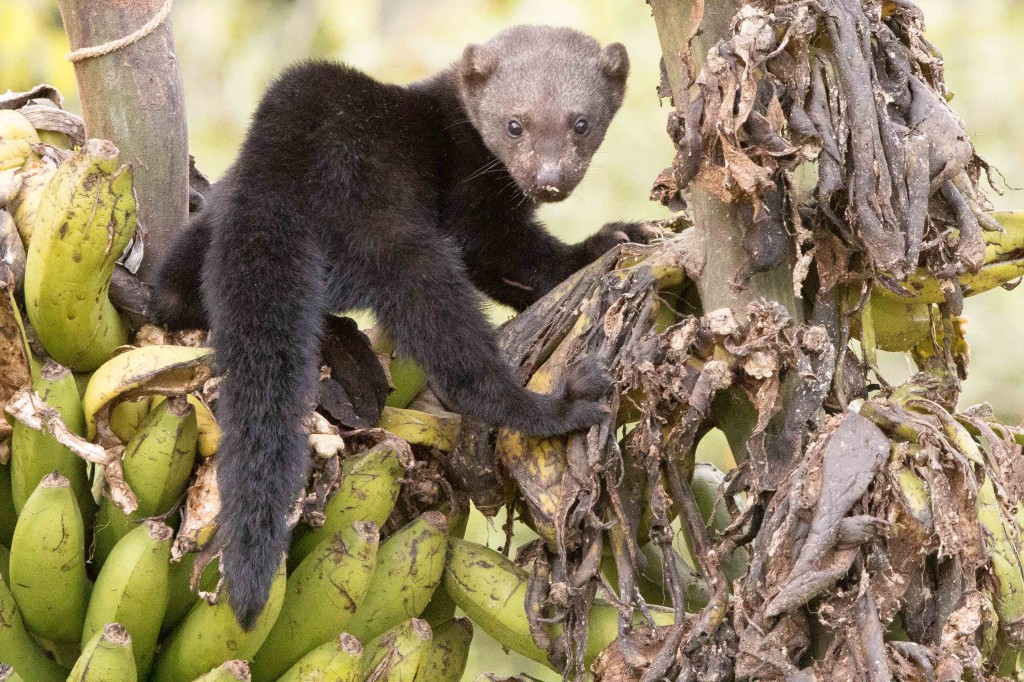
Tayra, Eira barbara, at El Jaguar
When Fiona Reid sent me her trip report from Nicaragua in early 2015 I may have let out a small anguished sob: 23 of the 87 species she saw would have been new for me. And then – rubbing salt in the wound – Mike Richardson saw a further five bats I hadn’t seen during three days after the trip. I needed to return to Nicaragua.
So in March 2016 I was back at Managua airport, meeting Jose Gabriel for a tailor made nine day twitch-fest. Jose is Nicaragua’s answer to Crocodile Dundee. He’s worked with Fiona Reid on her trips and is both a bat expert, all round naturalist and talented catcher of mammals. I travelled with him in 2014 and cannot recommend him highly enough. Once again Jose’s buddy and fellow bat researcher Luis came along with us to help set traps.
I had sent Jose a long and very ambitious wish list of 40 target species that either Fiona or Jose had seen in Nicaragua. But I only had nine days. It was a tall order and word began to reach me that Jose was taking it a bit too seriously, worrying I would be disappointed if we didn’t totally clean up. I tried to reassure him. He didn’t listen.
Managua to Santa Theresa: March 19
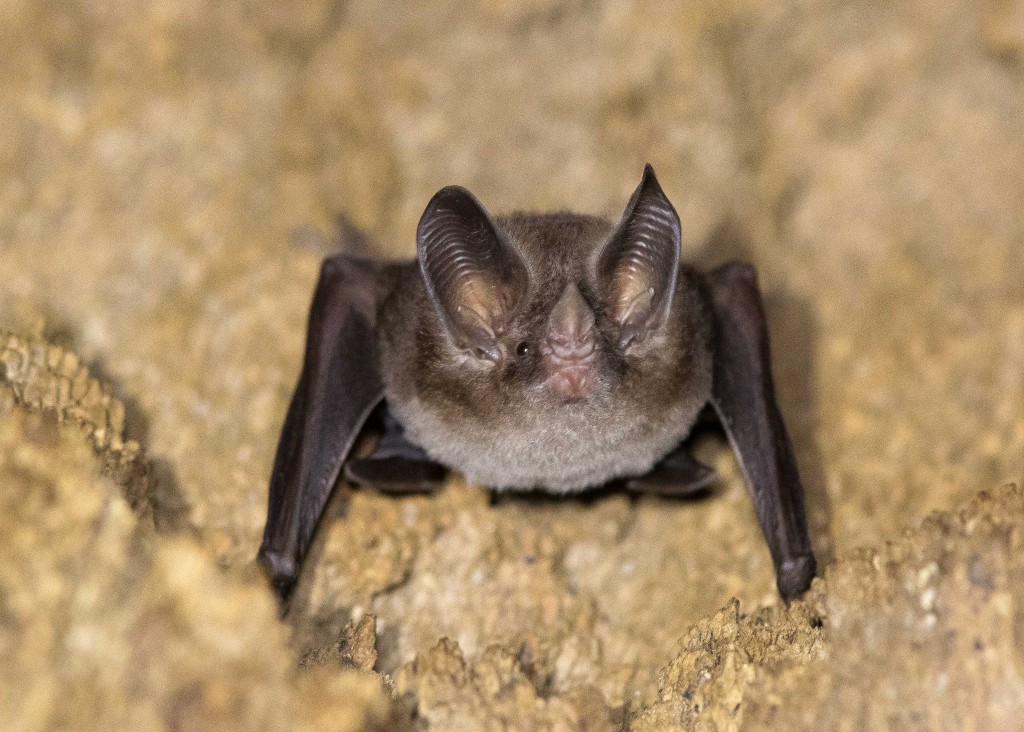
Tiny Big-eared Bat, Micronycteris minuta
I got into Managua after a short overnight connection in Guatemala. Beware: Guatemala City airport can be a cluster so get there early. Jose and Luis were waiting at the airport and we headed straight to Apoyo Lake to check out a couple of roost trees. Unfortunately – and much to Jose’s surprise – the Pale Spear-nosed Bats were not in their usual, and hitherto very reliable, roost, which housed just a few Greater Spear-nosed Bats and a few Short-tailed bats (probably Seba’s). A few hundred metres further on we checked another hollow tree and were successful: my first Tiny Big-eared Bats were at home (though as of early 2020 it seems bats identified as M. minuta might be a different species in Nicaragua – M. tresamici – pending further research).
Next stop was Masaya Volcano National Park, a place I’d visited on my previous trips but which still held a species I wanted to see: Hairy-legged Vampire Bats. But the park was shut. It had closed a month or so earlier because the volcano was active. The closure was, however, somewhat flexible it seemed until a wildfire, started a few days before I visited, added another level of complexity. The park closure was now being enforced strictly.
Undaunted, Jose brought his dirt bike with him so we could get into the park and visit the bat roost “through the back door”. A rugged ride for a few miles got us to the entrance of the cave. But there were no Vampire Bats at home, though there were plenty of Seba’s Short-tailed Bats and a few Merriam’s Long-tongued Bats. The roost isn’t particularly reliable but Jose had hoped that the closure of the park and lack of disturbance would have helped produce the bats. An early set back but we had plenty of time.
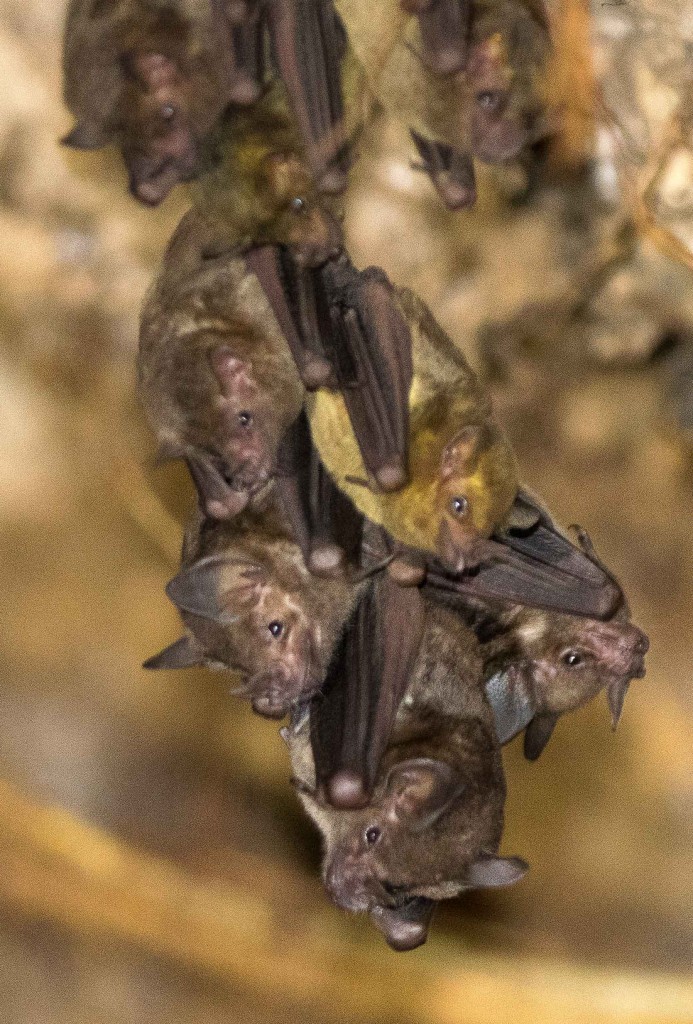
Seba’s Short-tailed Bats, Carollia perspicillata and a Merrriam’s Long-tongued Bat, Glossophoga mutica (the yellower animal)
After lunch we arrived at Santa Theresa, Jose’s home town. I stayed at Jose’s place which is also home to Nicaragua’s only know roost of Fierce Bonneted Bat. Jose had caught one the night before for me and I watched him release it back into the roof.
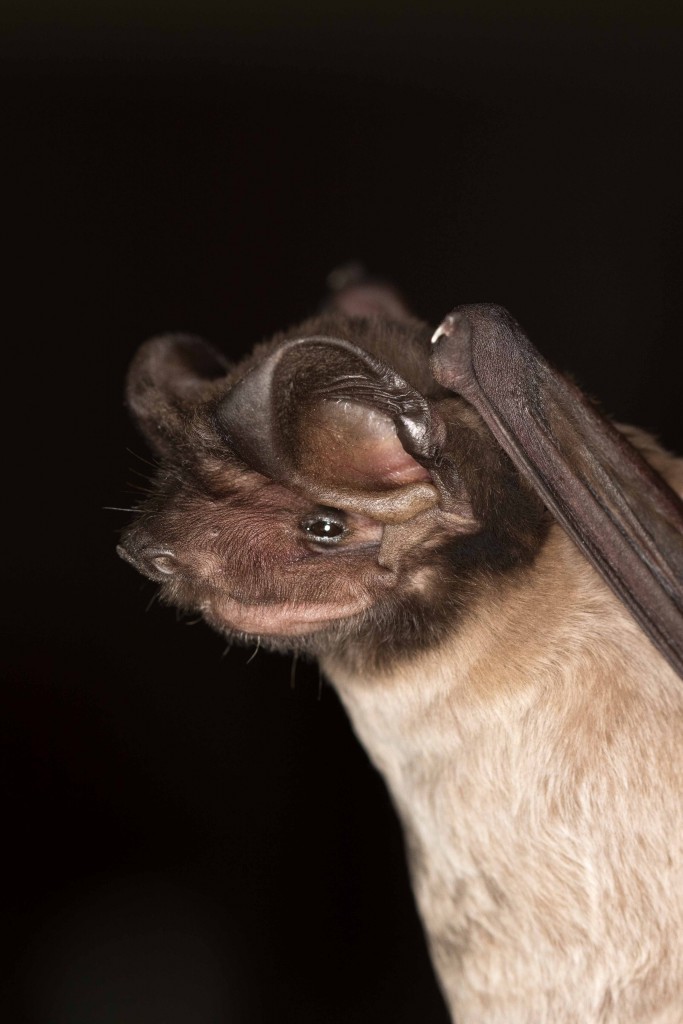
Fierce Bonneted Bat, Eumops ferox
We netted for bats that evening at Jose’s mother’s and father’s houses. The molossids in his dad’s roof were obliging and we caught the uncommon – or uncommonly caught at least – Big Crested Mastiff Bat.
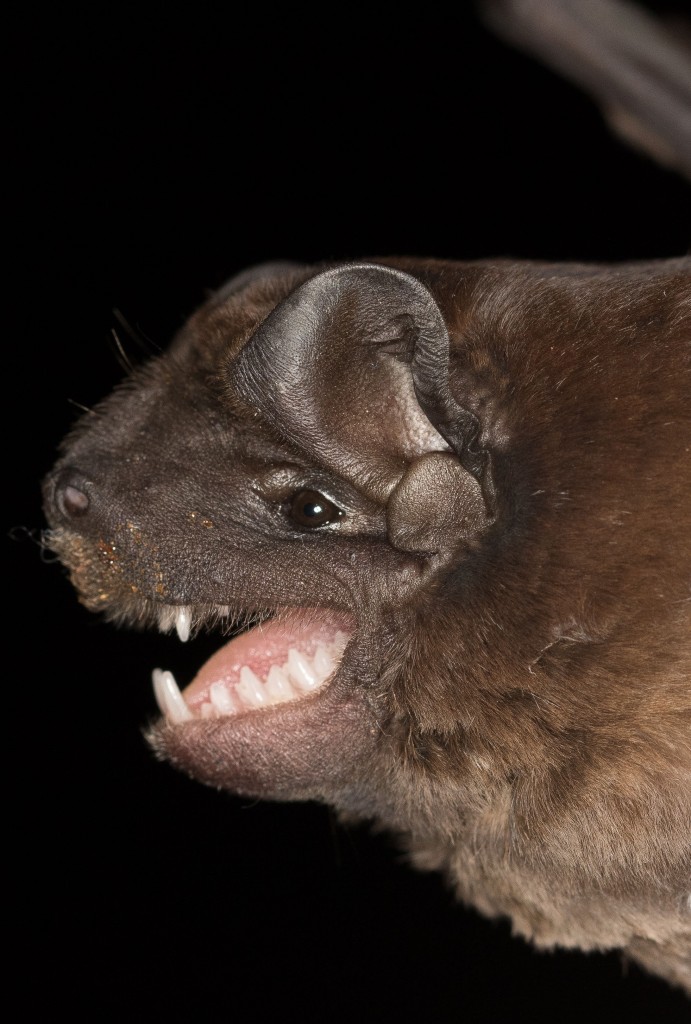
Big Crested Mastiff Bat, Promops centralis
and Alvarez’s Mastiff Bat,
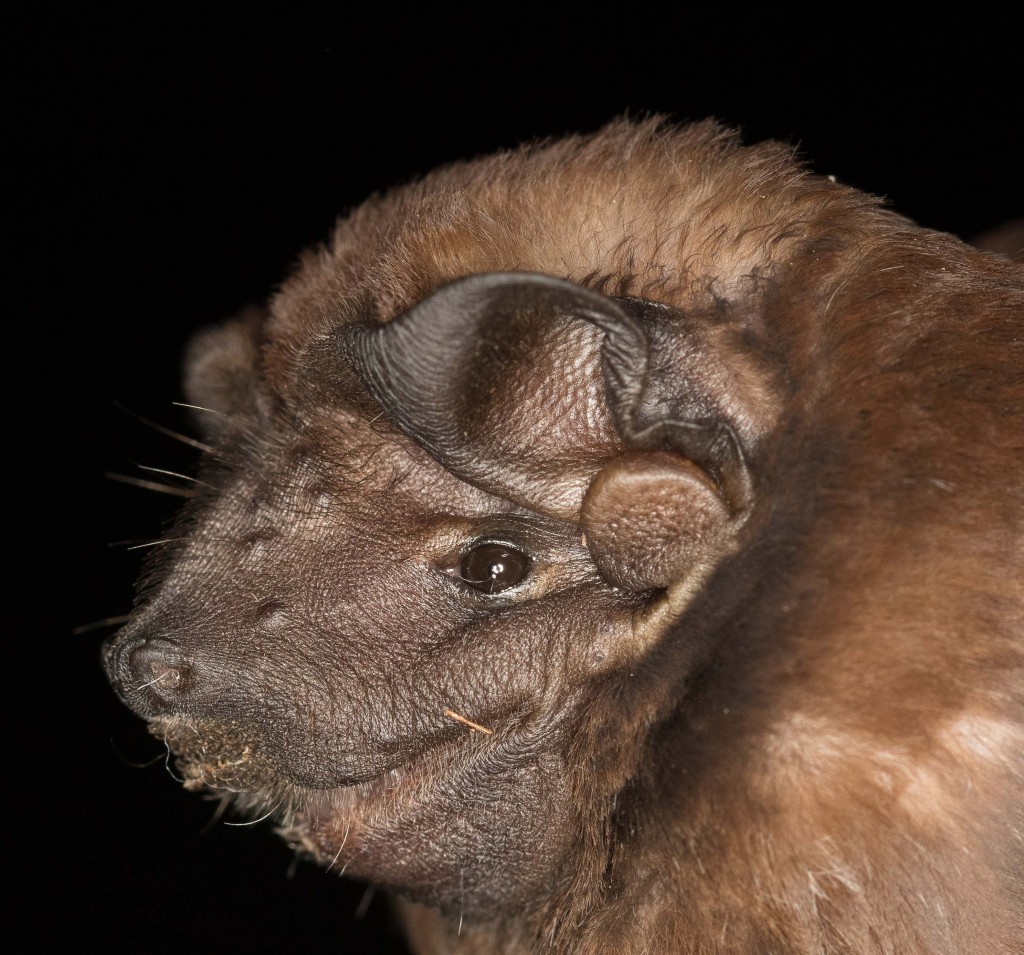
Alvarez’s Mastiff Bat, Molossus alvarezi
as well as Little Mastiff Bats.
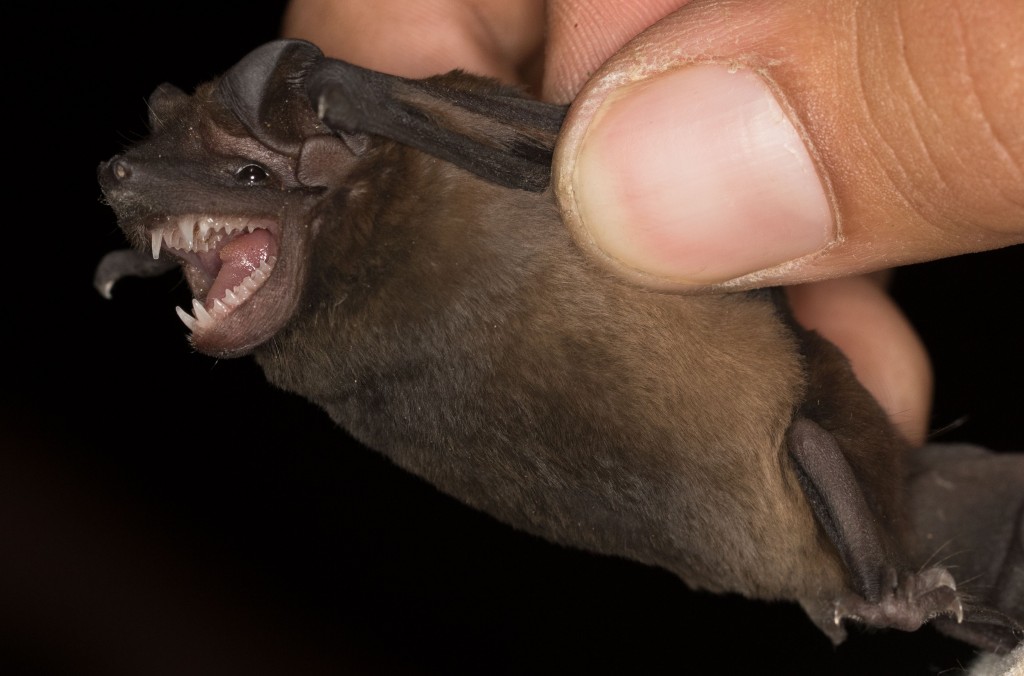
Little Mastiff Bat, Molossus molossus
At his mother’s property we added Central American Yellow Bat,
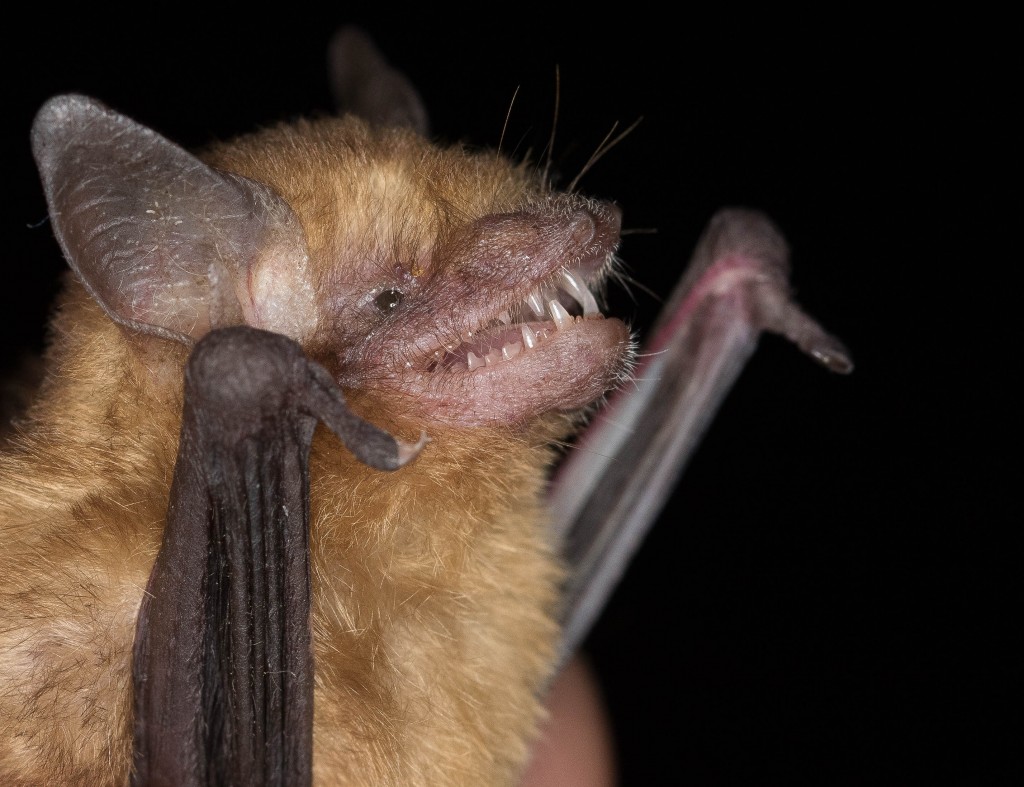
Central American Yellow Bat, Rhogeessa tumida
Argentinian Brown Bat,
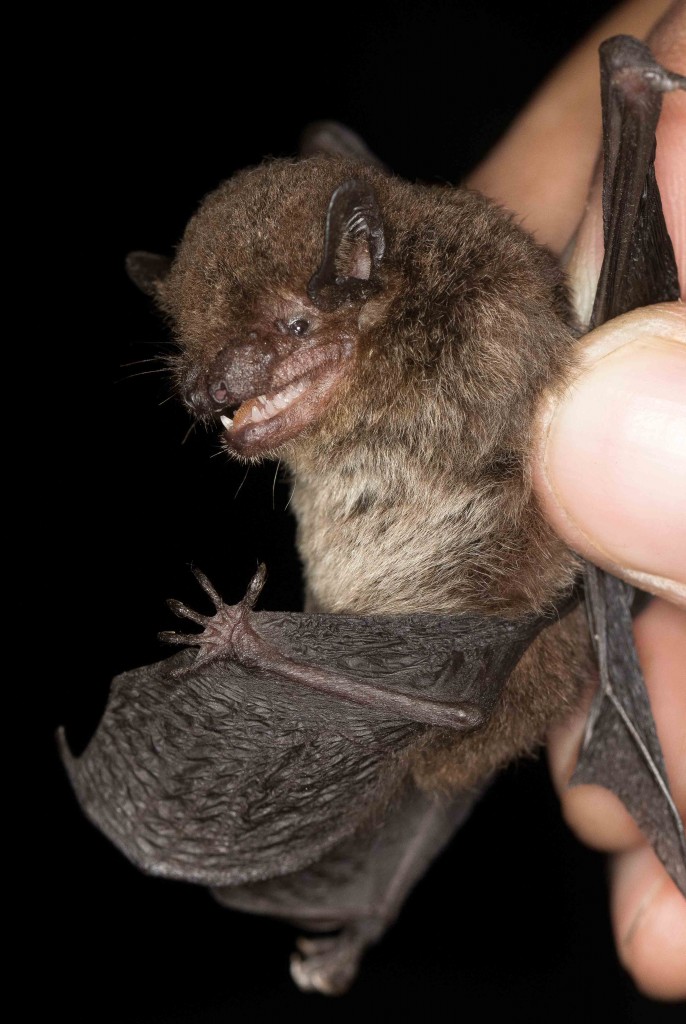
Argentinian Brown Bat, Eptesicus furinalis
Little Yellow-shouldered Bat
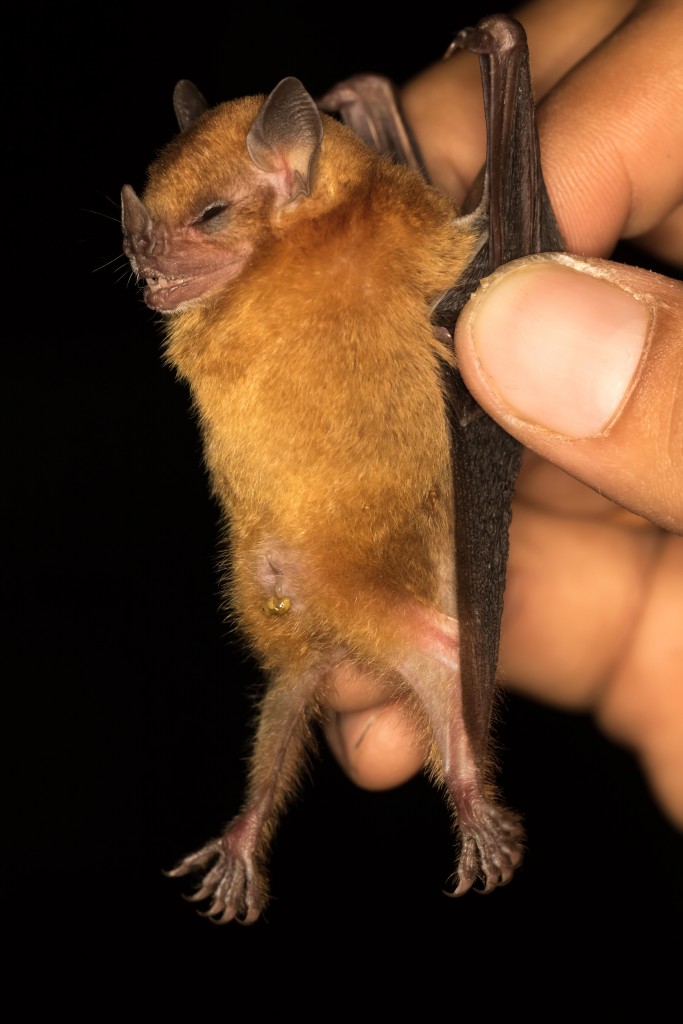
Little Yellow-shouldered Bat, Sturnira illium
and Bonda Mastiff, all of which were new for me.
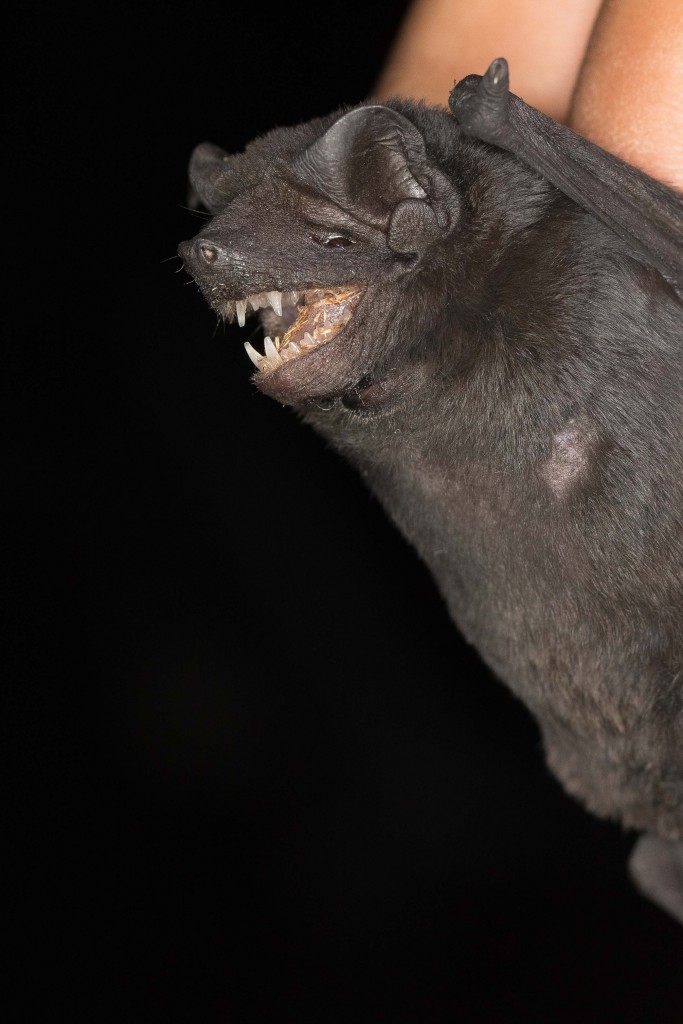
Bonda Mastiff Bat, Molossus bondae
We also caught Jamaican Fruit-eating Bats and Common Moustached Bats. Eight new species on the first day. Off to a flying start.
Rivas: March 20 to 22
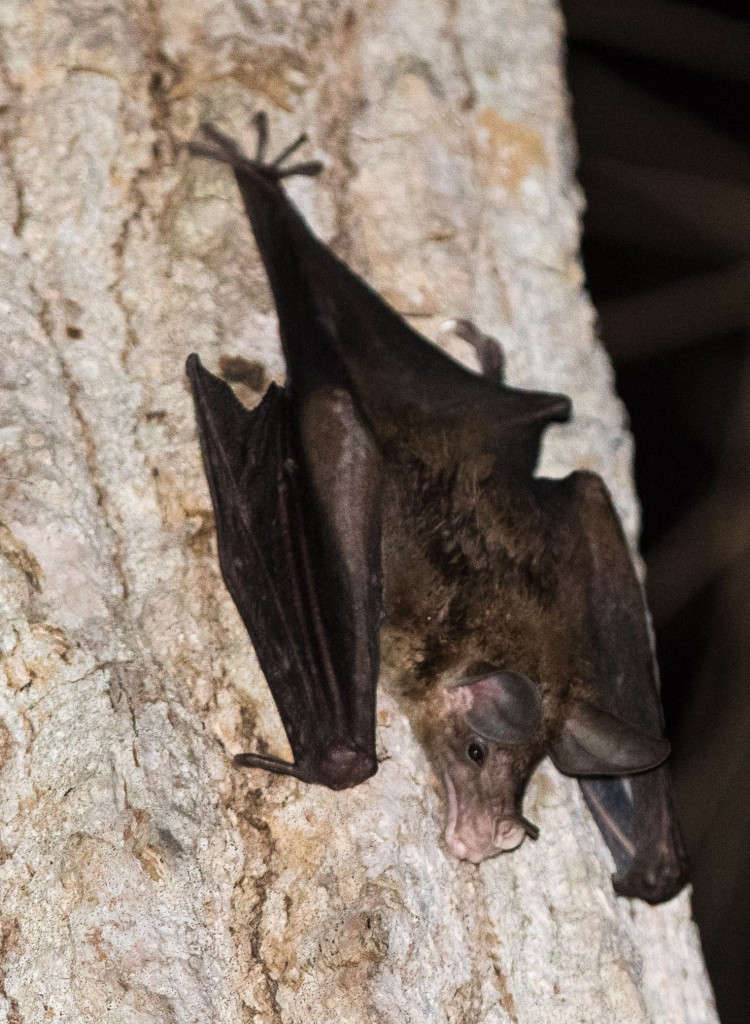
Spectral Bat,Vampyrum spectrum, Rivas
Rivas is a three hour drive from Santa Theresa. We based ourselves at the small beach community of El Ostional. The Manta Ray Hotel, right on the beach, was basic but very friendly.
After a swim and an excellent lunch we drove 30 minutes to some dry (bone dry in the current drought) forest. We checked a couple of roost trees, one of which held a colony of micronycteris. Our photos were inconclusive: one animal appeared to be M. hirsuta, while the others might be M. schmidtorum, which was a species Jose had found roosting several times before in the reserve.
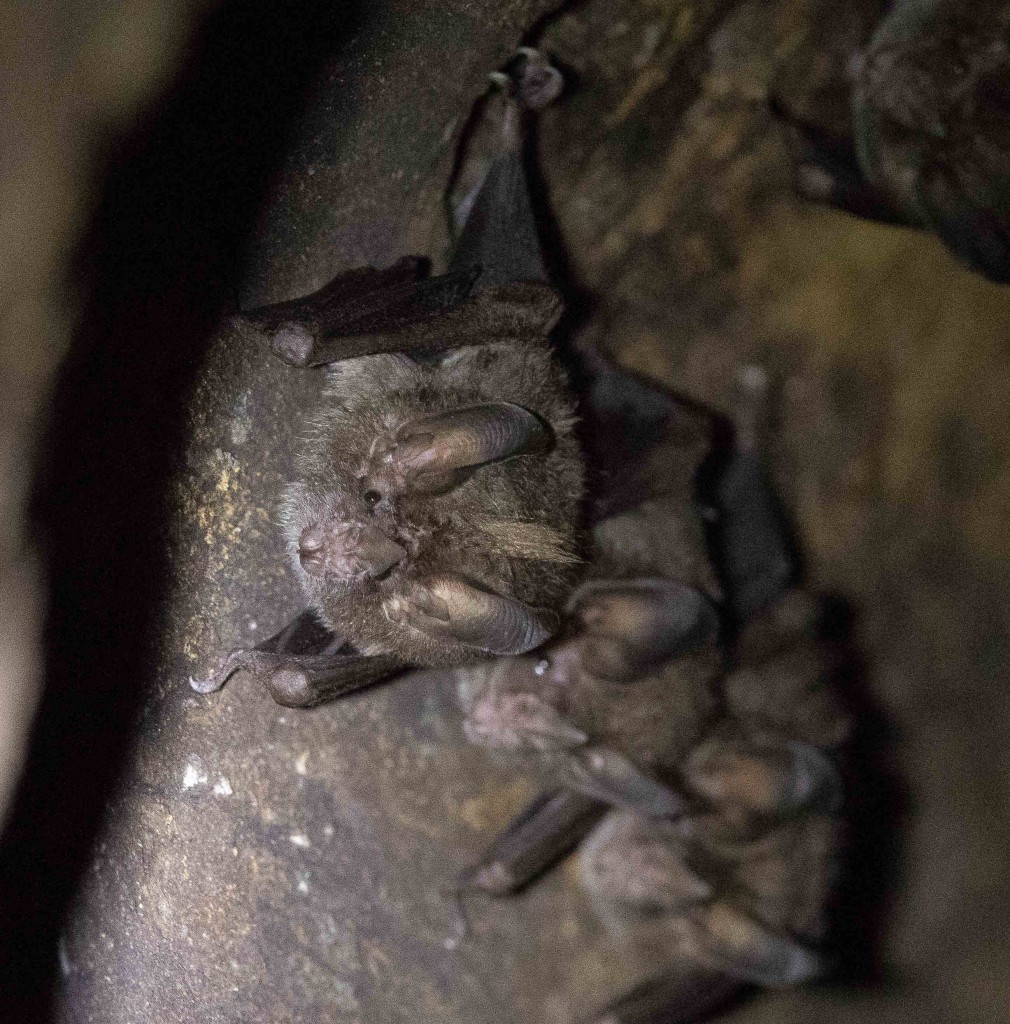
Hairy Big-eared Bat, Micronycteris hirsuta (front), and friends…
Another tree held a few Common Vampires and some carollia bats. A very sick Howler Monkey kept watch and Luis spotted a Variegated Squirrel.
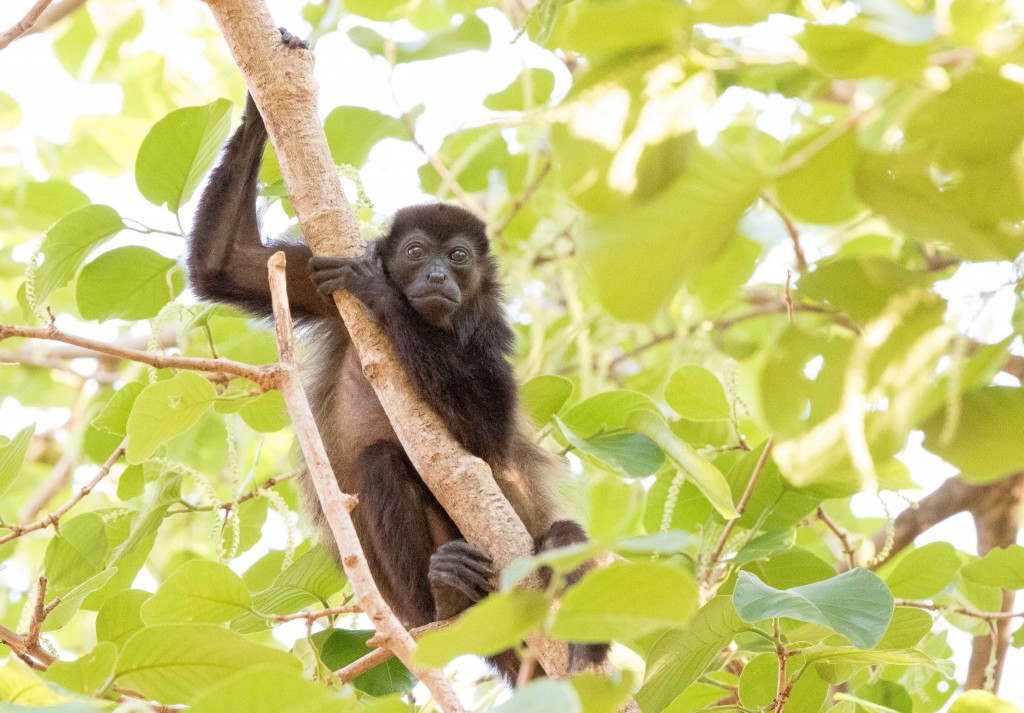
Mantled Howler Monkey, Alouatta palliata
Jose and Luis set four nets that evening around some pools, a spot that had proven very successful during Fiona’s tours.

Ostional netting site
A Mexican Porcupine emerged from its roost soon after sunset and posed obligingly for a photo.
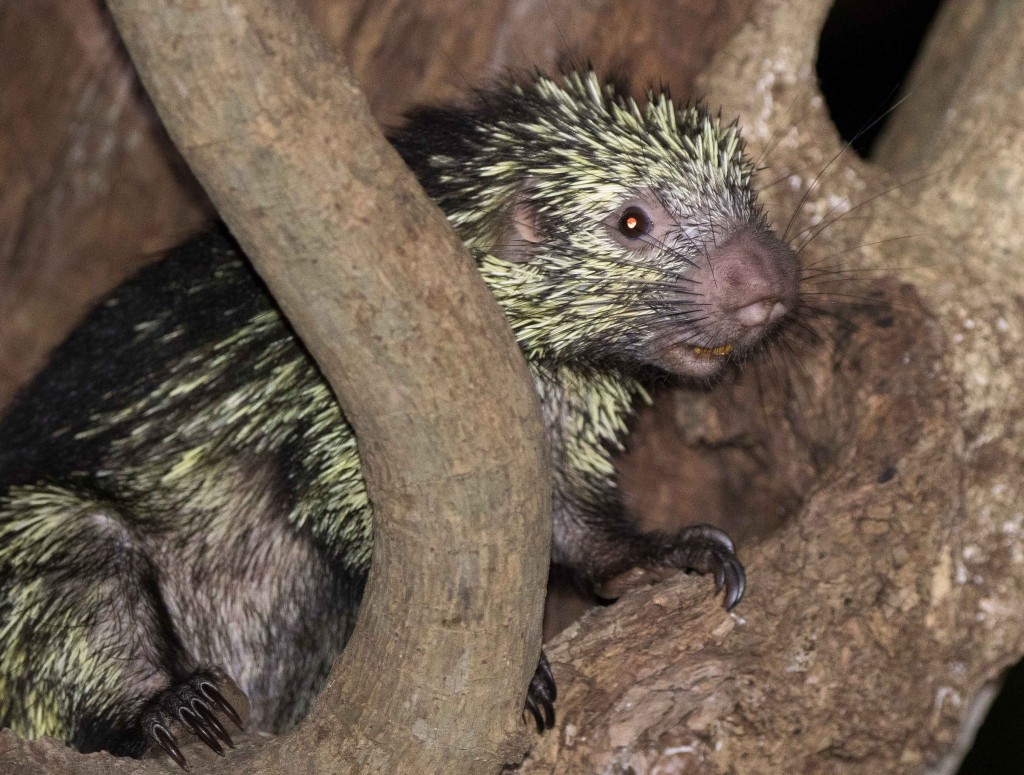
Mexican Hairy Dwarf Porcupine, Sphiggurus mexicanus
While a Common Opossum played possum.
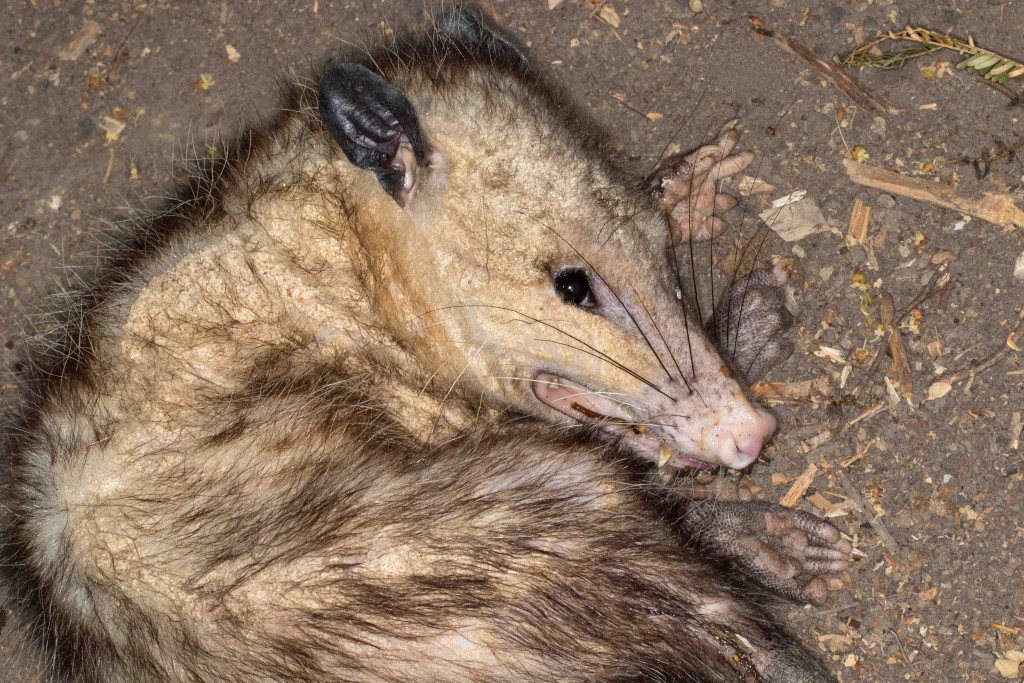
Common Opossum, Didelphis marsupialis
We netted from dusk til gone 11 p.m. and again from 3 a.m. til dawn. Jose was worried about the full moon but bat activity and diversity was high. We caught 15 species: the best of which was undoubtedly a Mexican Dog-faced Bat (now split from Greenhal’s Dog-faced Bat).
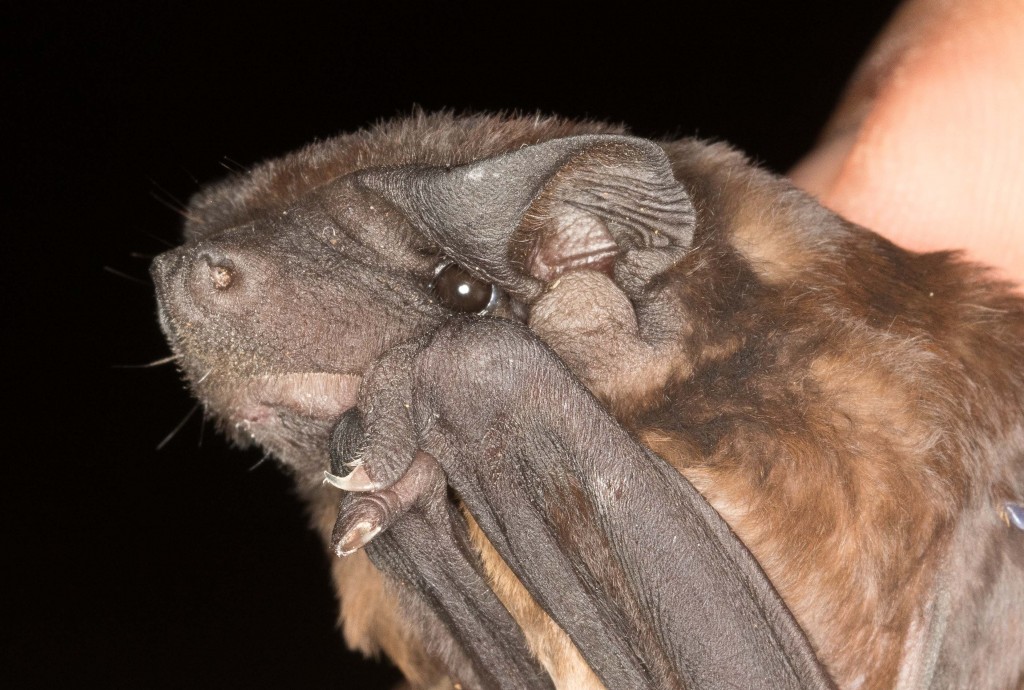
Mexican Dog-faced bat, Cynomops mexicanus
Other new species for me included Miller’s Mastiff Bat;
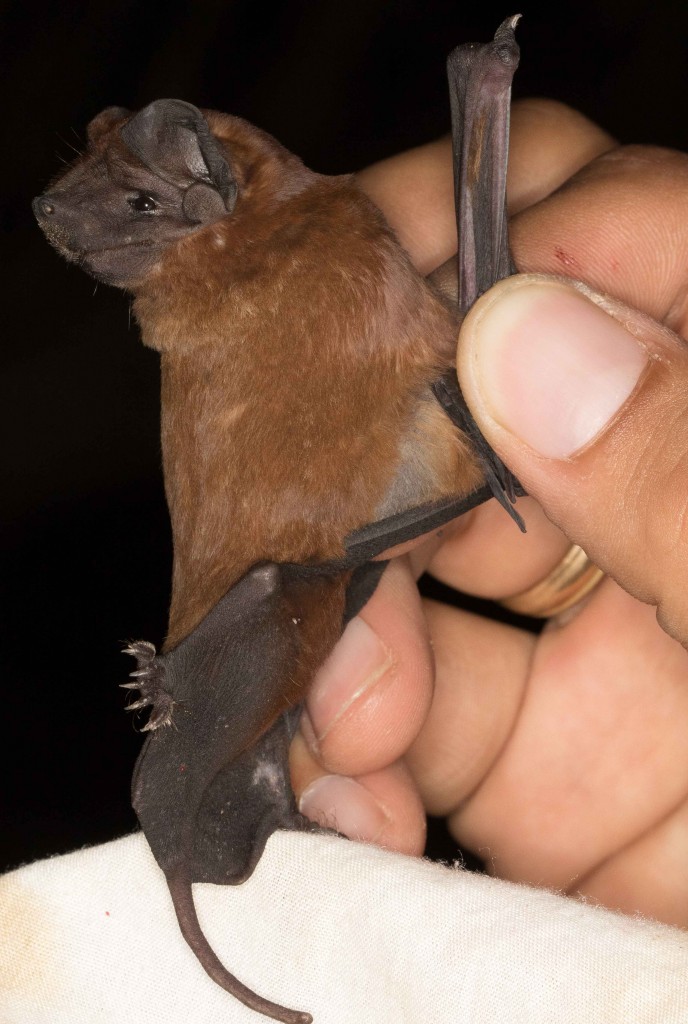
Miller’s Mastiff Bat, Molossus pretiosus
a Mexican Funnel-eared Bat;
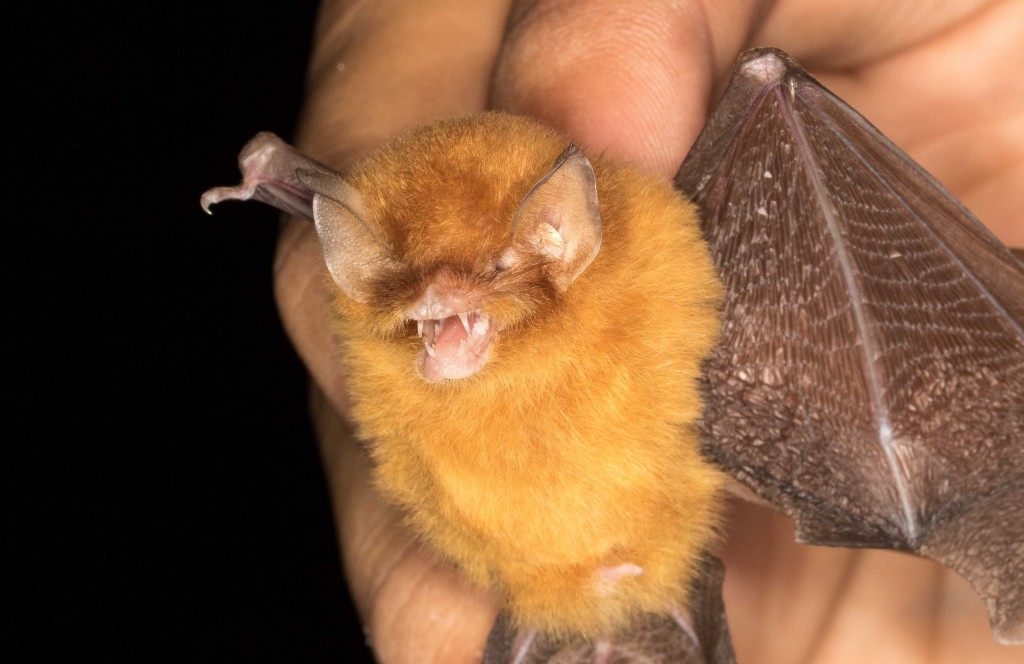
Mexican Funnel-eared Bat, Natalus mexicanus
and a Northern Round-eared Bat.
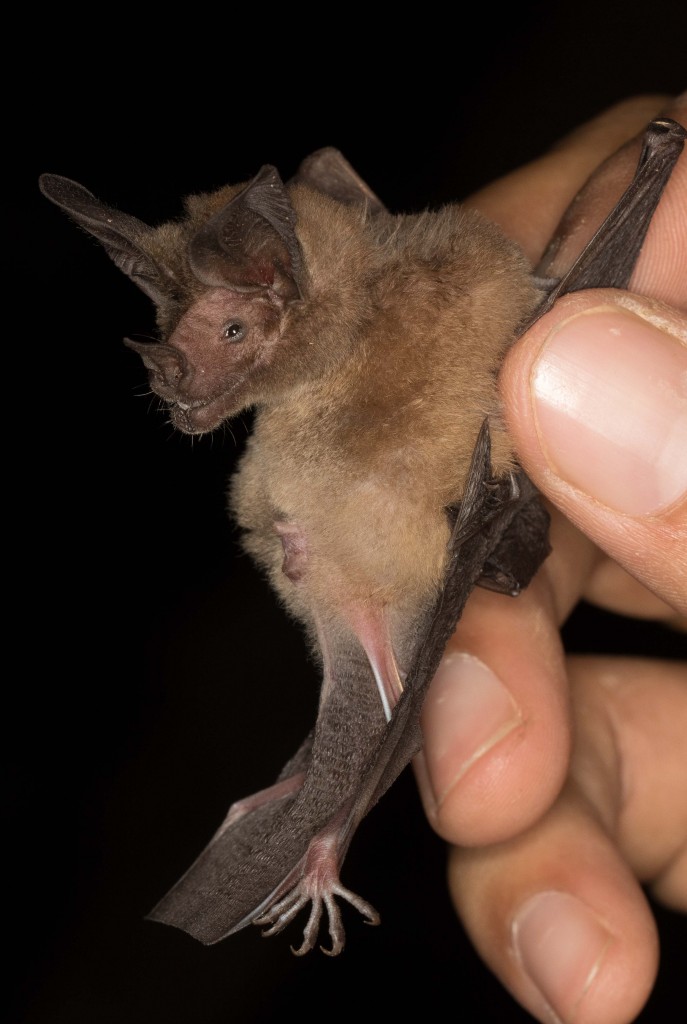
Northern Round-eared Bat, Lophostoma nicaraguae
We added another two species I had not seen before in the hand: Greater Fishing Bat
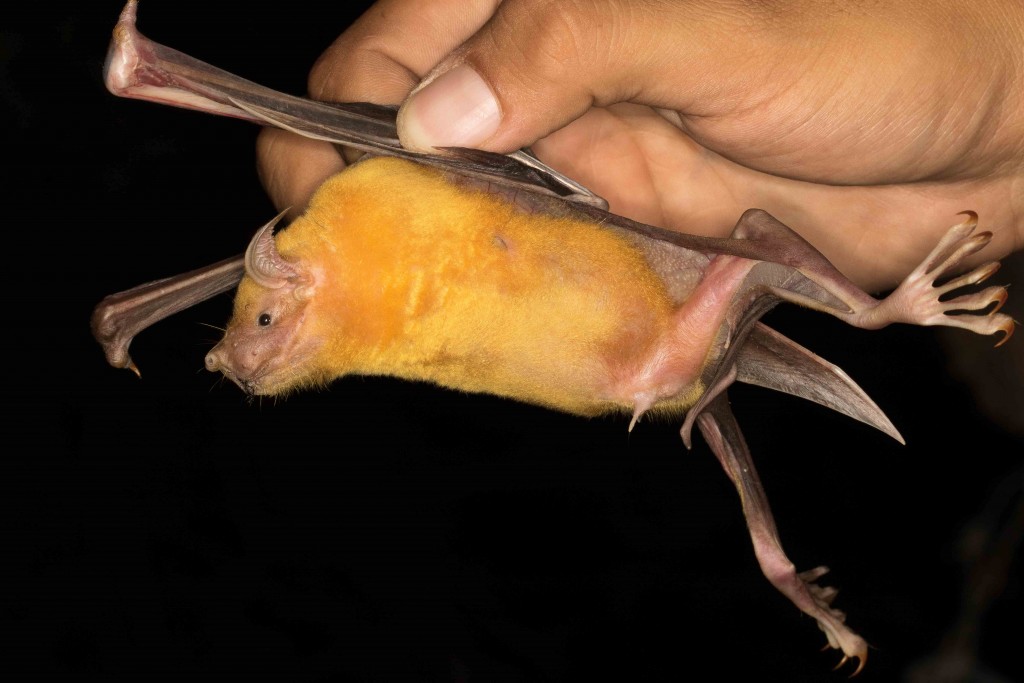
Greater Fishing Bat, Noctilio leporinus
and a Tiny Big-eared Bat, a species that I had seen for the first time on Saturday at Apoyo Lake.
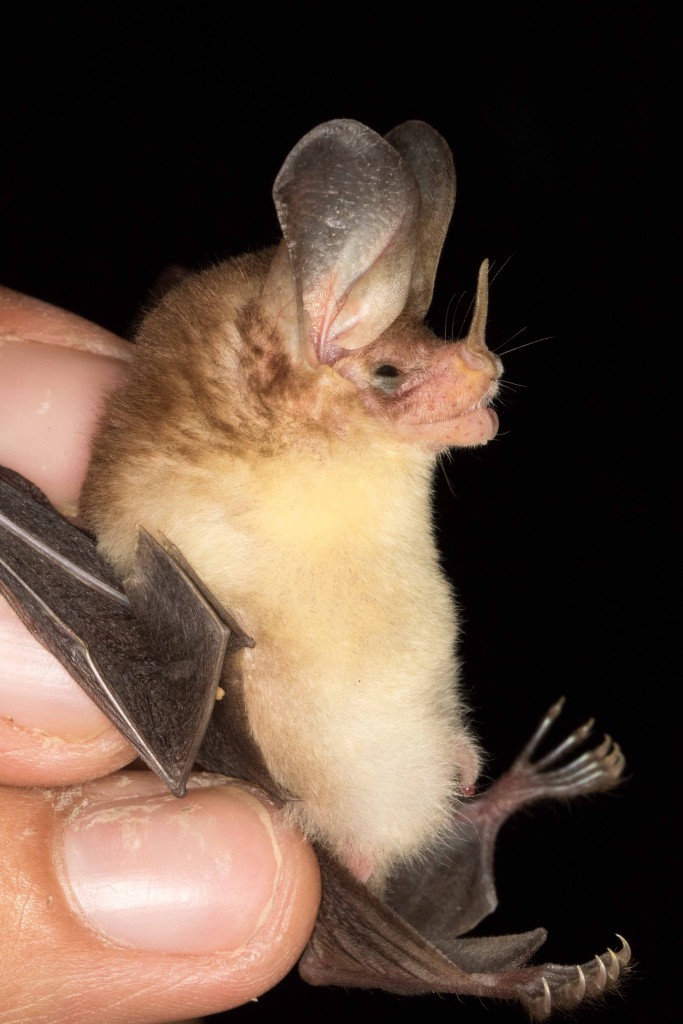
Tiny Big-eared Bat, Micronycteris minuta
The other species comprised more Sturnira Ilium and Rhogeessa tumid along with three pteronotus species, one of which was a Mesomaerican Moustached Bat, with the other two below.
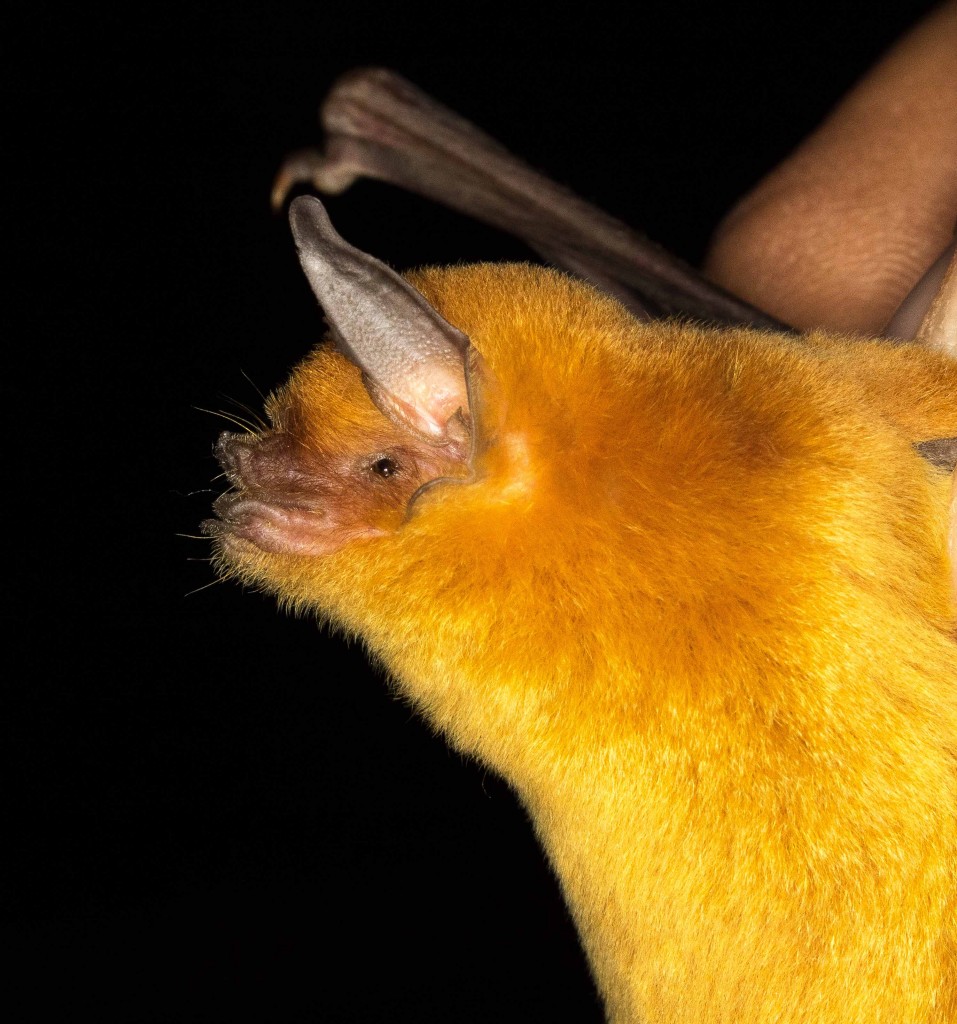
Lesser Moustached Bat Pteronotus personatus
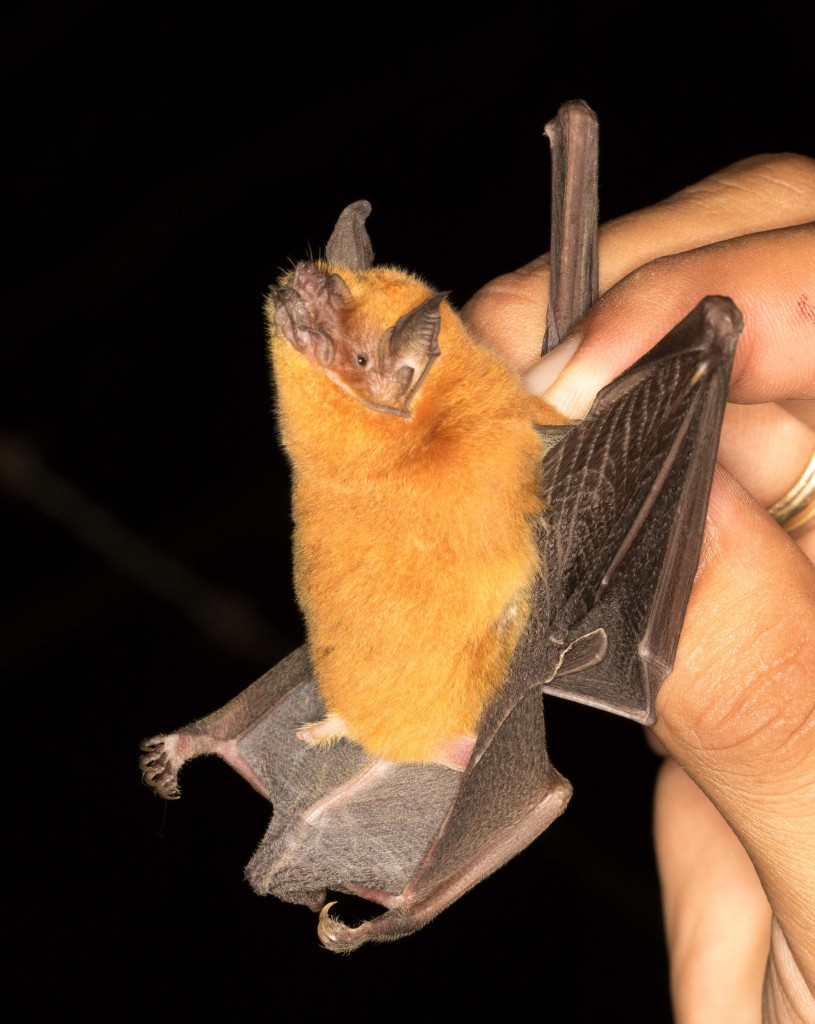
Big Naked-backed Bat, Pteronotus gymnonotus
We also caught more Little Mastiff and Argentinian Brown Bats along with three more species that were new for this trip: Thomas’s Fruit-eating Bat, Gray Short-tailed Bat and Northern Stripe-headed Round-eared Bat.
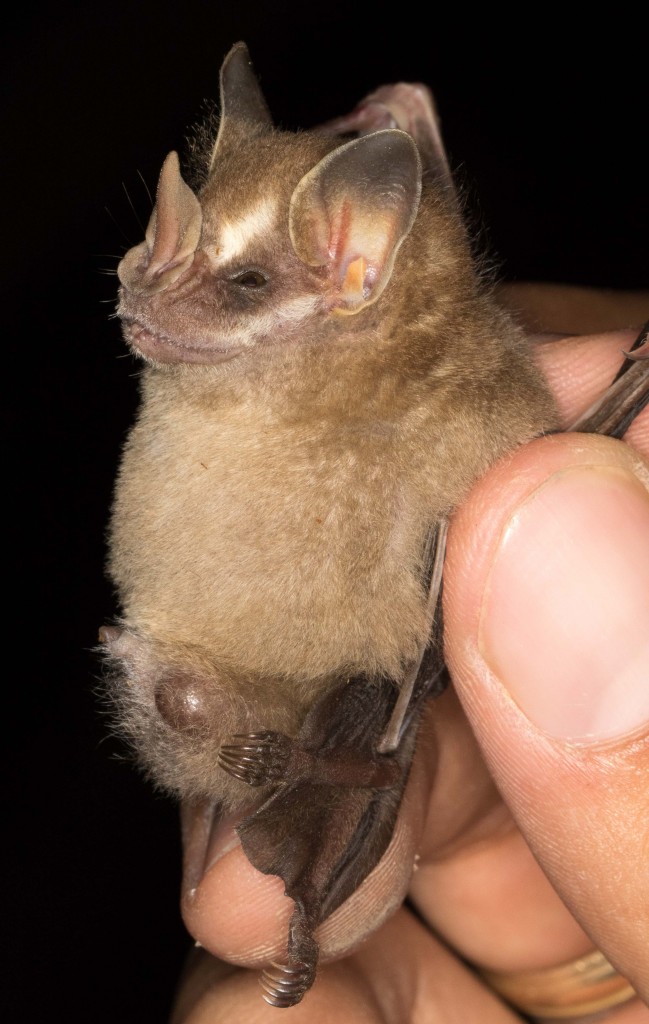
Thomas’s Fruit-eating Bat, Artibeus watsoni
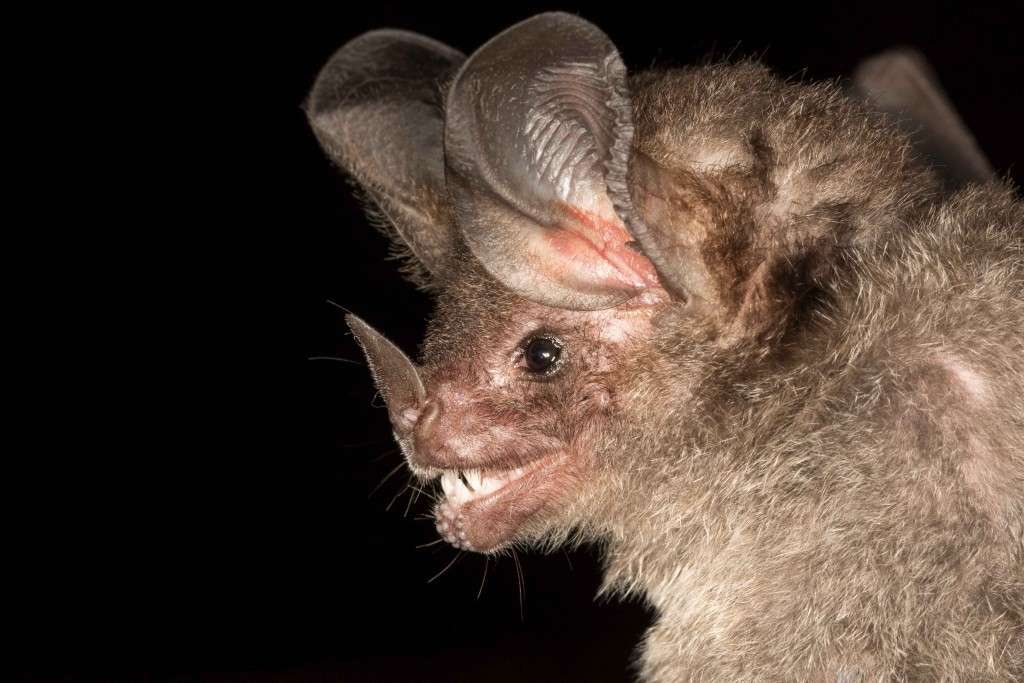
Northern Stripe-headed Round-eared Bat, Tonatia bakeri
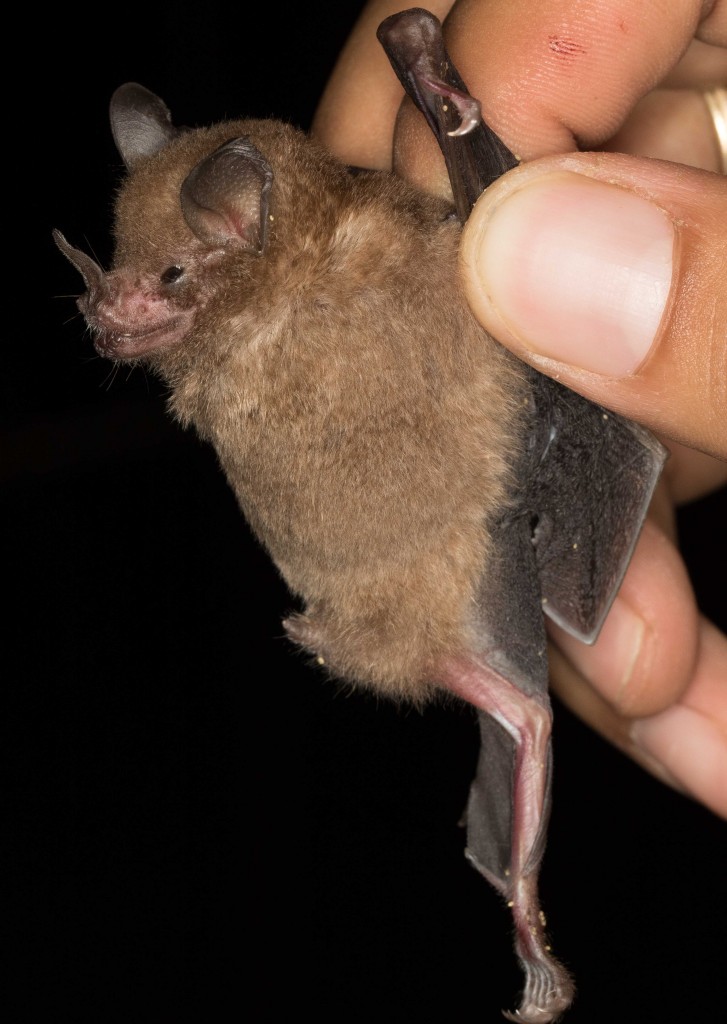
Gray Short-tailed Bat, Carollia subrufa
Driving between the forest and El Ostional in the small hours of the morning we saw several Hooded and Striped Hog-nosed Skunks, the latter a key target for me.
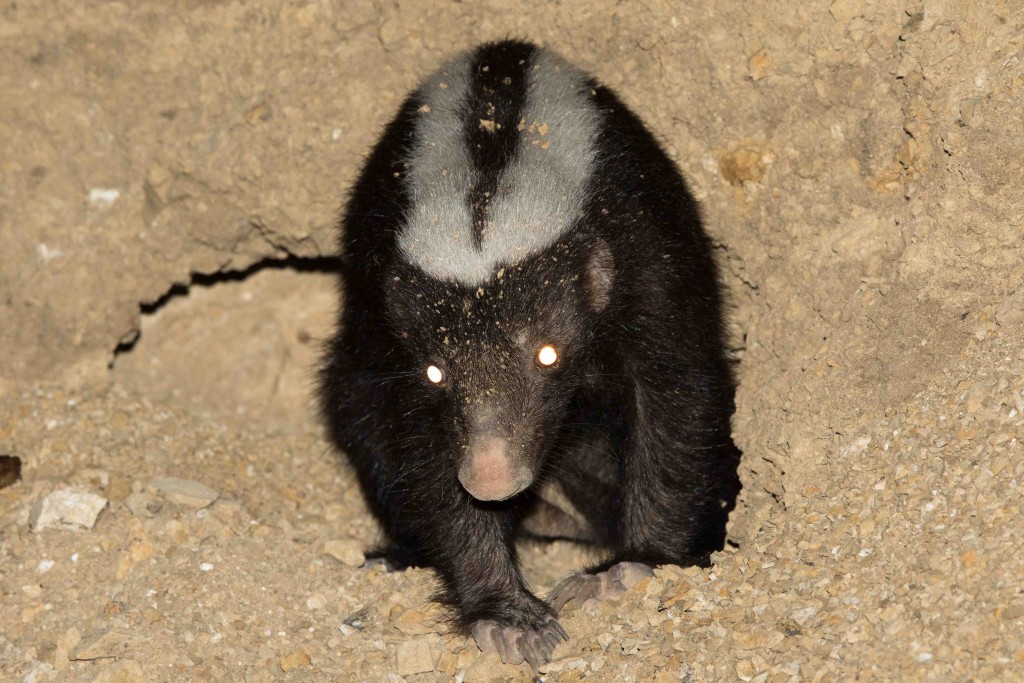
Striped Hog-nosed Skunk, Conepatus semistriatus
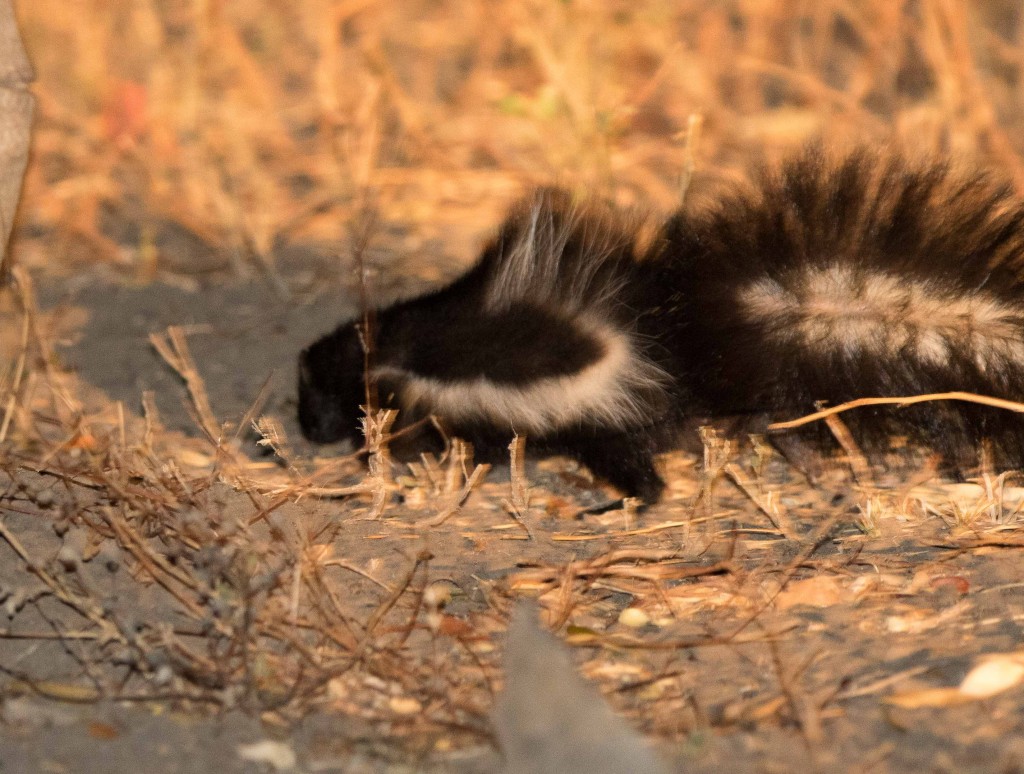
Hooded Skunk, Mephitis macroura
Jose and I took a shortish walk that night and added a couple of Kinkajous, and a Northern Tamandua to the night’s haul. Not bad!
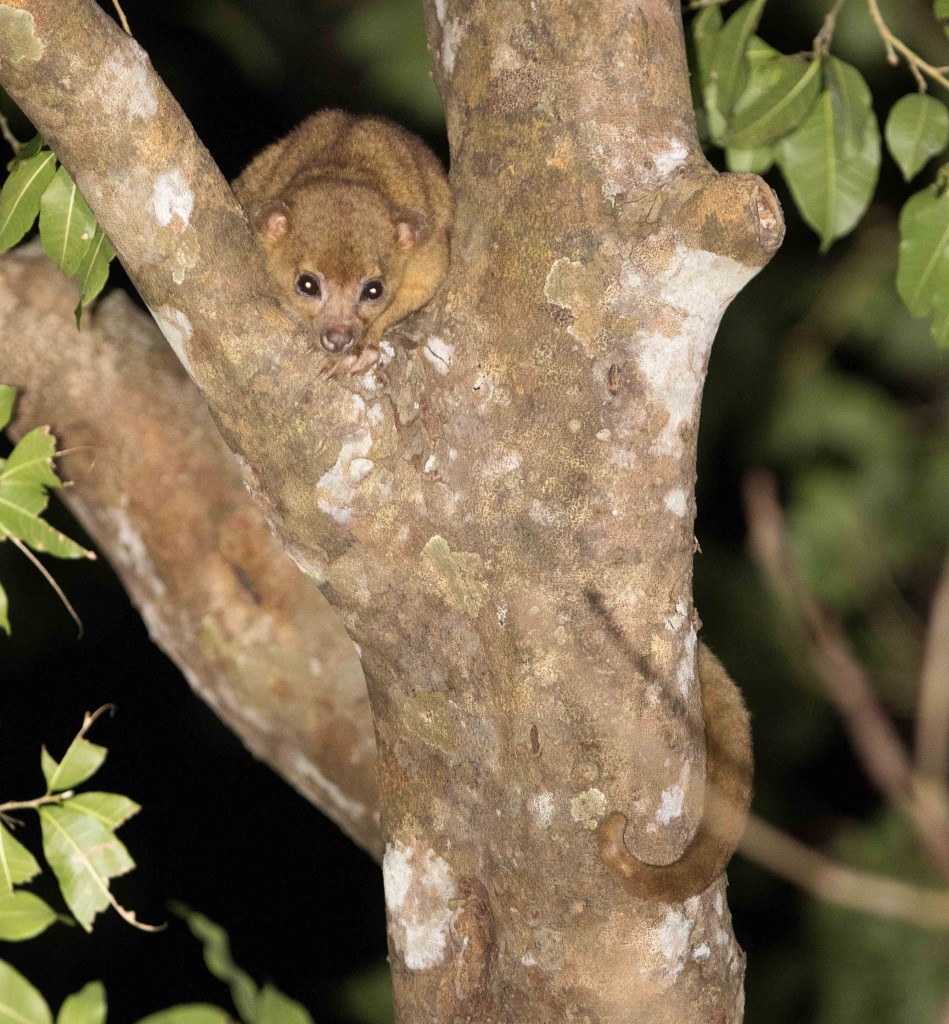
Kinkajou, Potos flavus
There were still at least four bats I hoped to see in the area: the very cool Wrinkle-faced Bat, White-throated Round-eared Bat, Niceforo’s Bat and Pale-throated Bat. All rare, but Fiona had caught the former 3 species in 2015 and the latter in Feb 2016. We still had two nights.
I also wanted to see a Vampyrum spectrum properly after I’d seen one flapping around the canopy tower in Panama in 2014. And so Jose suggested we should try netting at Escamequita on our second night, as Fiona had scored there on both her trips.
But first we wanted to visit some caves, so we spent our second afternoon driving the 2.5 hours to and from El Abuelo caves. Our key targets were Mexican and Woolly Funnel-eared Bats and Long-legged Bats, all of which are hard to net (though we had caught a few Natalus mexicanus the day before). El Abuelo comprises four small caves and access is pretty easy, though we needed a gas mask for the last, ammonia-filled, cave which still stank from the several thousand Moustached Bats that had briefly resided there.
The funnel-eared bats were easy to see and Jose spotted a couple of the nervous Long-legged Bats , their long legs trailing behind them distinctively in flight. I failed dismally trying to photograph the only one that perched where I could see it.
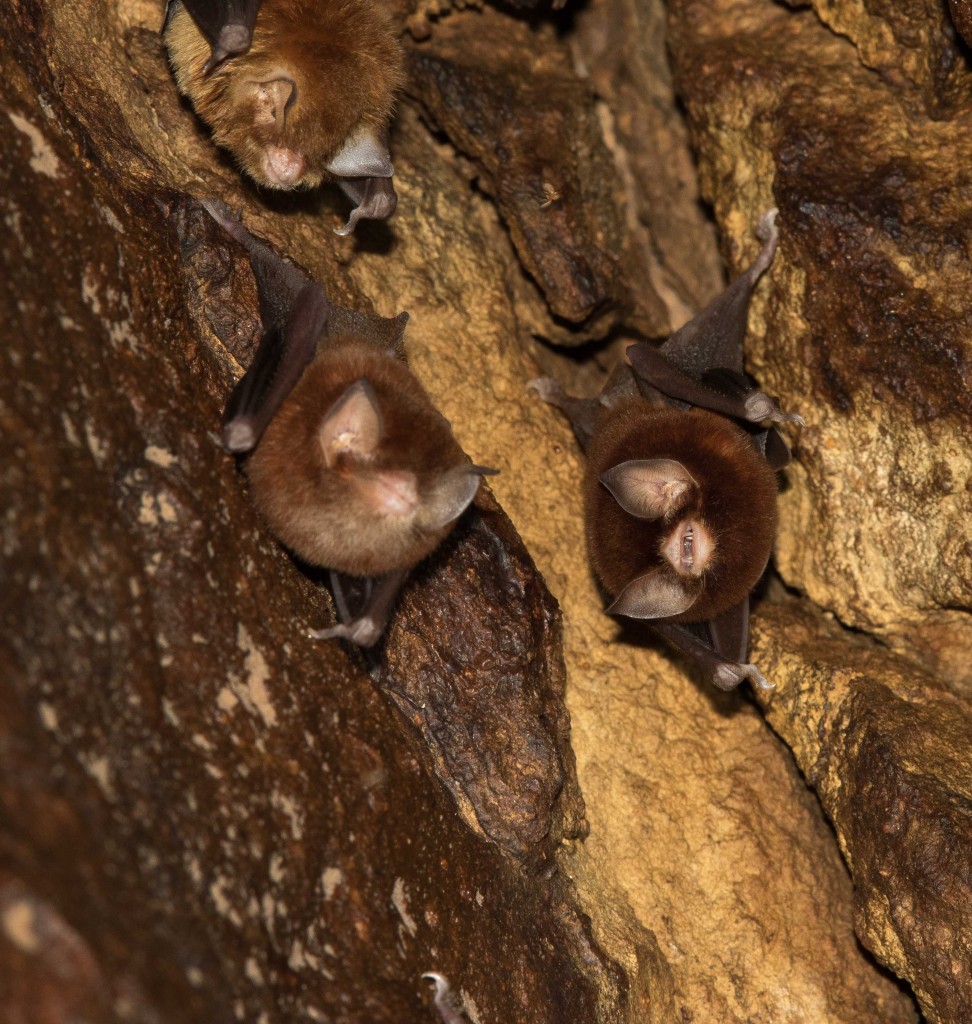
Mexican Funnel-eared Bats, Natalus mexicanus
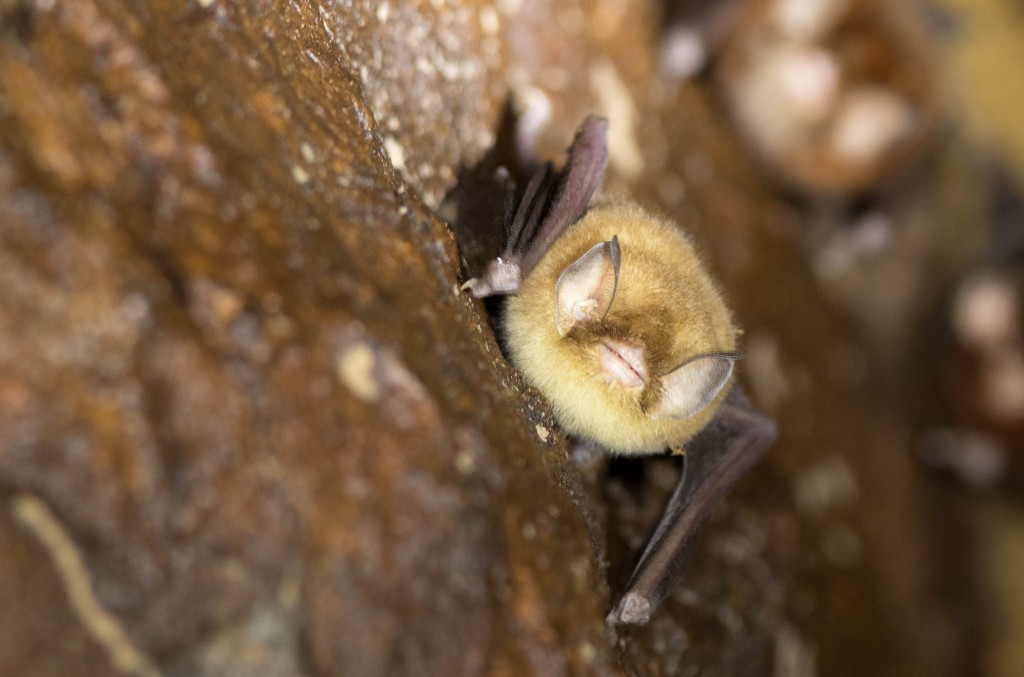
Woolly Funnel-eared Bat, Natalus lanatus
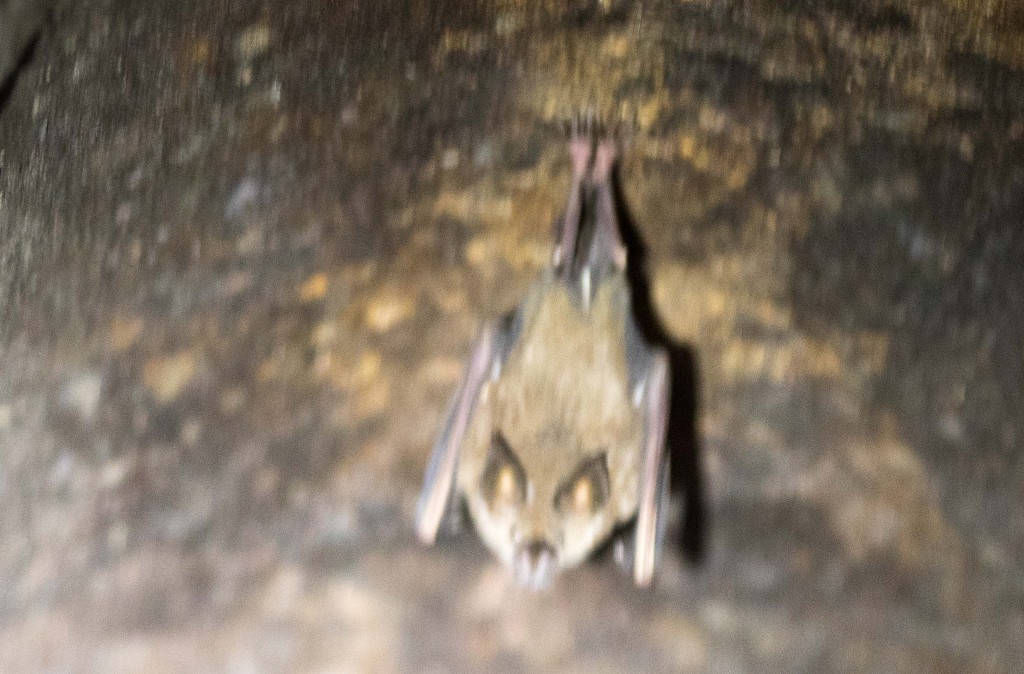
Long-legged Bat, Macrophyllum macrophyllum
The caves also held some Lesser Dog-like Bats, Gray Sac-winged Bats and a Fringe-lipped Bat. And a troop of Spider Monkeys and a White-throated Capuchin put in an appearance on the short walk back to the truck.
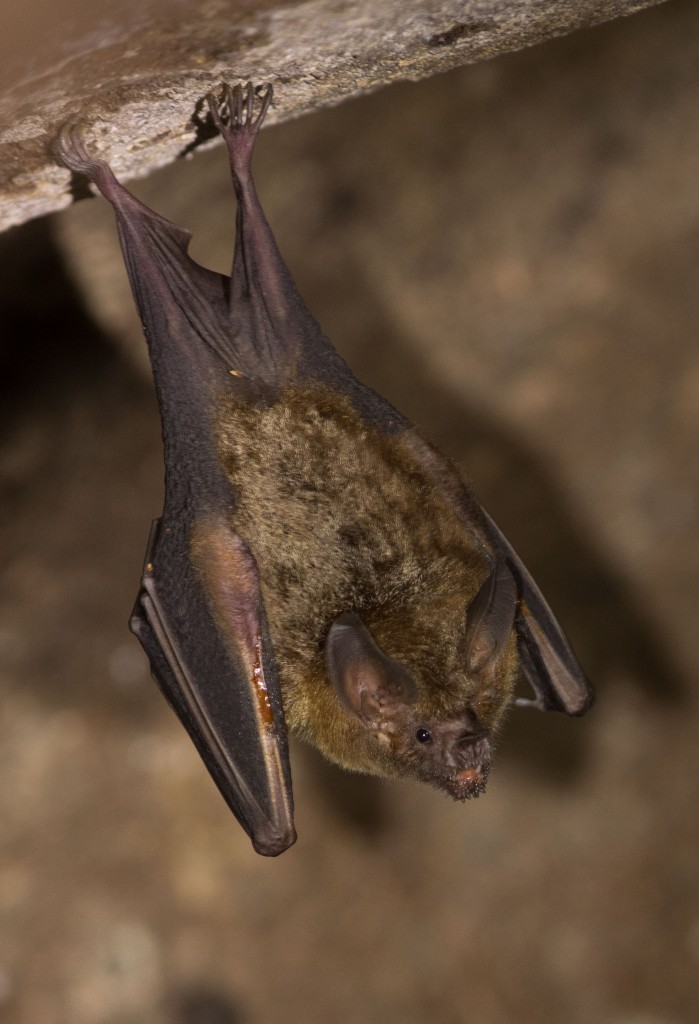
Fringe-lipped Bat, Trachops cirrhosus
We got to Escamequita about an hour after dark and set a couple of nets around a small pool (the Spectral Bat hotspot) and another in the forest. We stayed all night though I spent most of it asleep in the back of the truck.
The batting was steady throughout the night, and we caught nine species, none of which were new for me, though one was new for the trip – a Great Fruit-eating Bat.
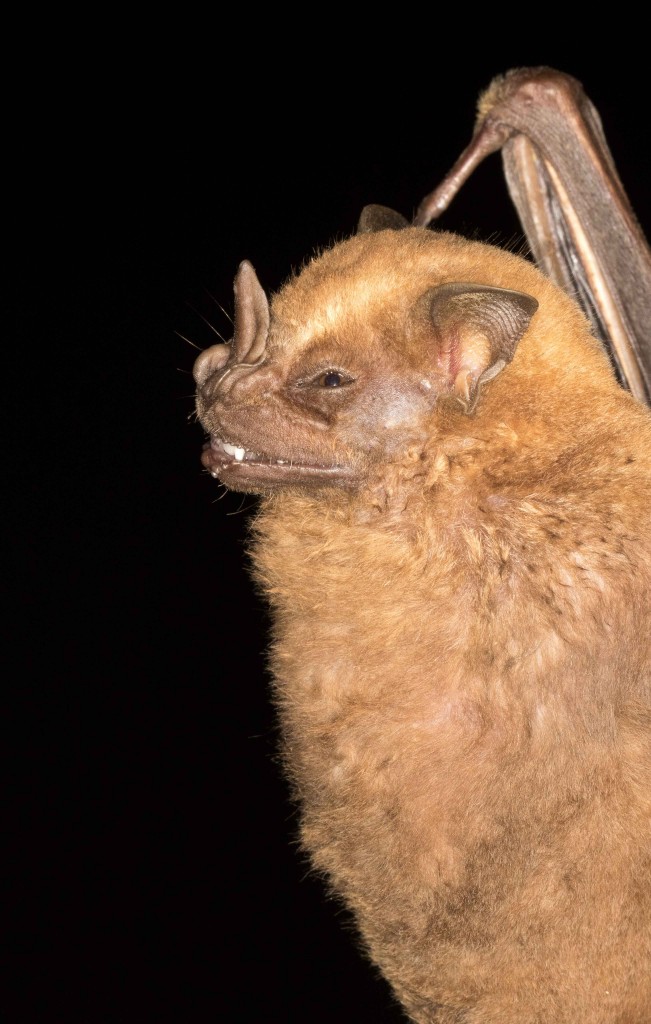
Great Fruit-eating Bat, Artibeus lituratus
Sadly no Spectral Bat. It was, however, very windy with a full moon that set only at 4.30 a.m.
There were quite a few mammals snuffling around the forest near the nets. More Striped Hog-nosed and Hooded Skunks, a couple of Kinkajous, Common Woolly and Common Opossums, and Jose saw a Southern Spotted Skunk.
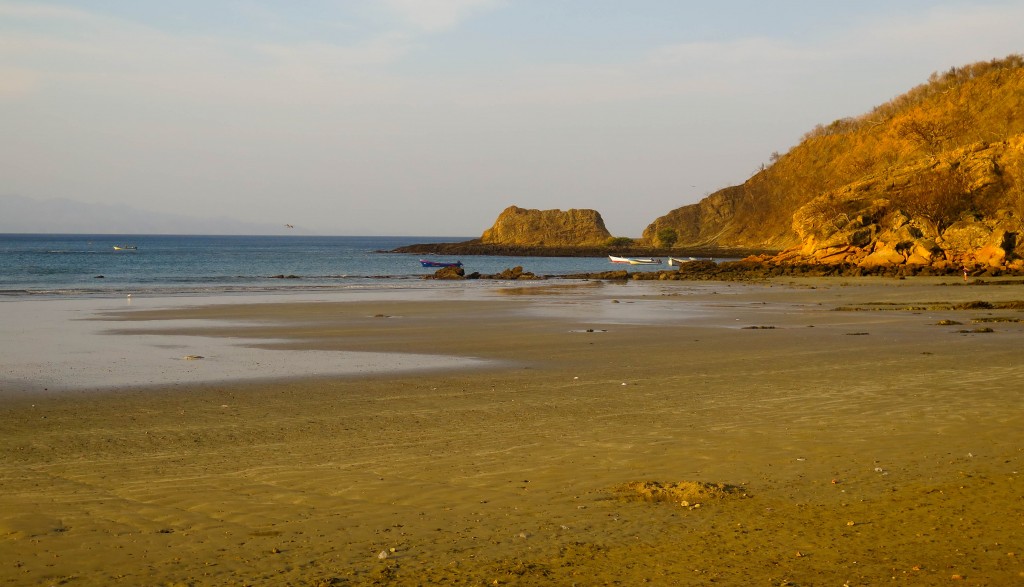
Ostional Beach
We rested all the next morning and returned to the forest we netted on our first day in mid-afternoon for our third and final night in the area. We spent a couple of hours looking for bats in tree hollows and aerial termite mounds (for lophostoma species). Apart from several Vampire Bat roosts and some carollias and Greater White-lined Bats, Jose also found two micronycteris roosts. Both, he thought, were Schmidts’ Big-eared Bat , the commonest micronycteris species in the forest he believed. I got some decent photos of the second roost. The first new species of the day.
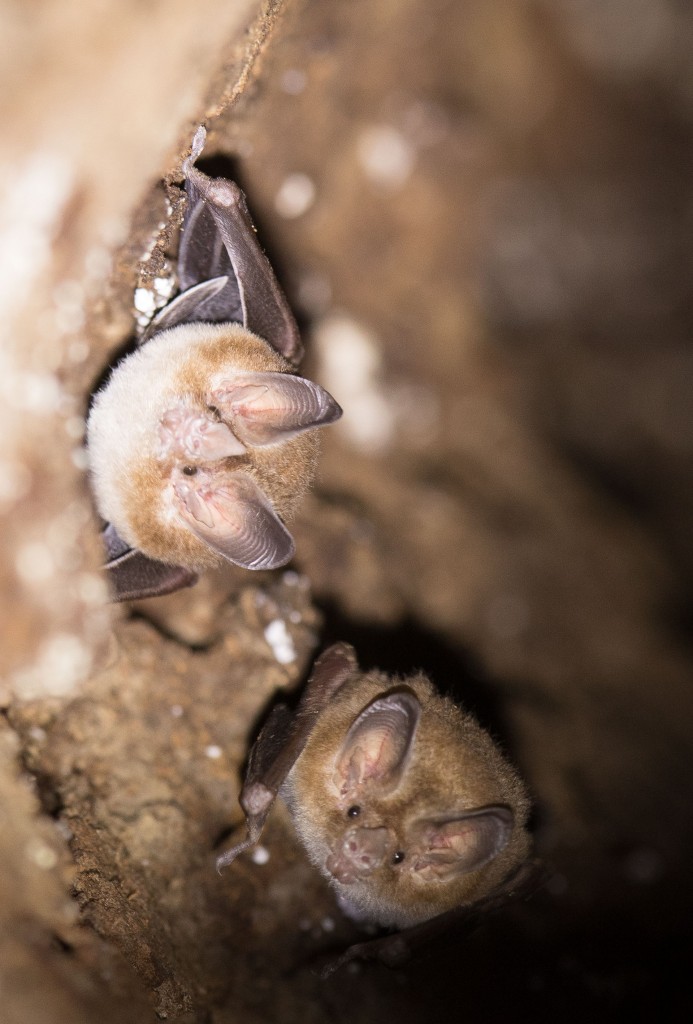
Schmidts’ Big-eared Bat, Micronycteris schmidtorum
We set two nets in the forest, near to where Fiona had caught a Pale-throated Bat in 2016, and two nets back at the pools. The moon was again very bright and – unusually for the time of year – the wind was gusting strongly. Luis called after an hour to say he had caught something cool by the hot springs. But he wouldn’t say what. I managed to contain my excitement for 30 minutes. But when Jose asked whether we should go see what Luis had, I was in the truck quicker than a New Yorker into an empty cab during a rainy rush hour.
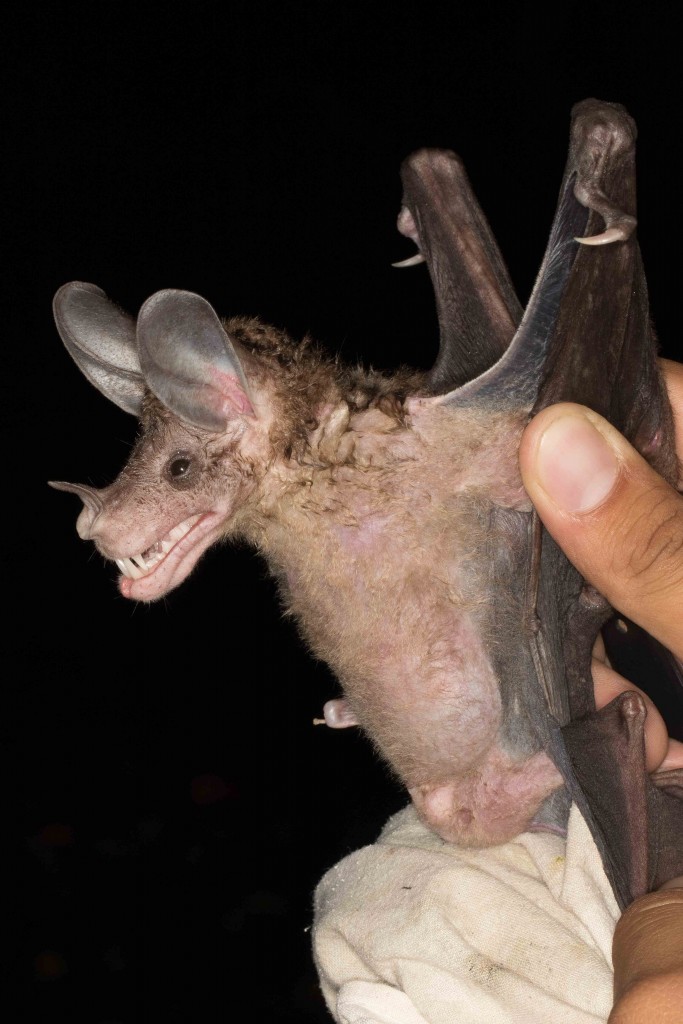
Spectral Bat, Vampyrum spectrum
Luis, as we had guessed, had a Spectral Bat Vampyrum spectrum. Bats do not come any cooler. What is more, when we arrived he had a second Spectral Bat in the net, plus another largish bat that Jose confirmed was a Pale-throated Spear-nosed Bat, the species we had missed in their usual roost on my first day. Double bingo!
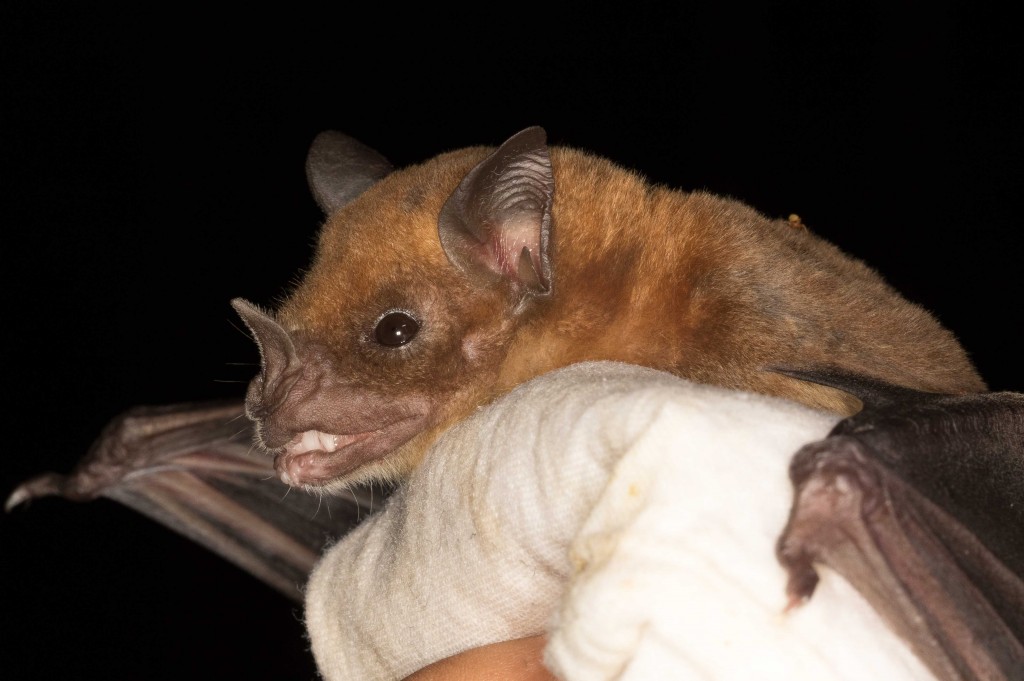
Pale Spear-nosed Bat, Phyllostomus discolor
Catching a Spectral Bat is always a big deal. Catching two in an evening is almost unheard of. Jose had previously only seen 4 in his life. A long photo session ensued.
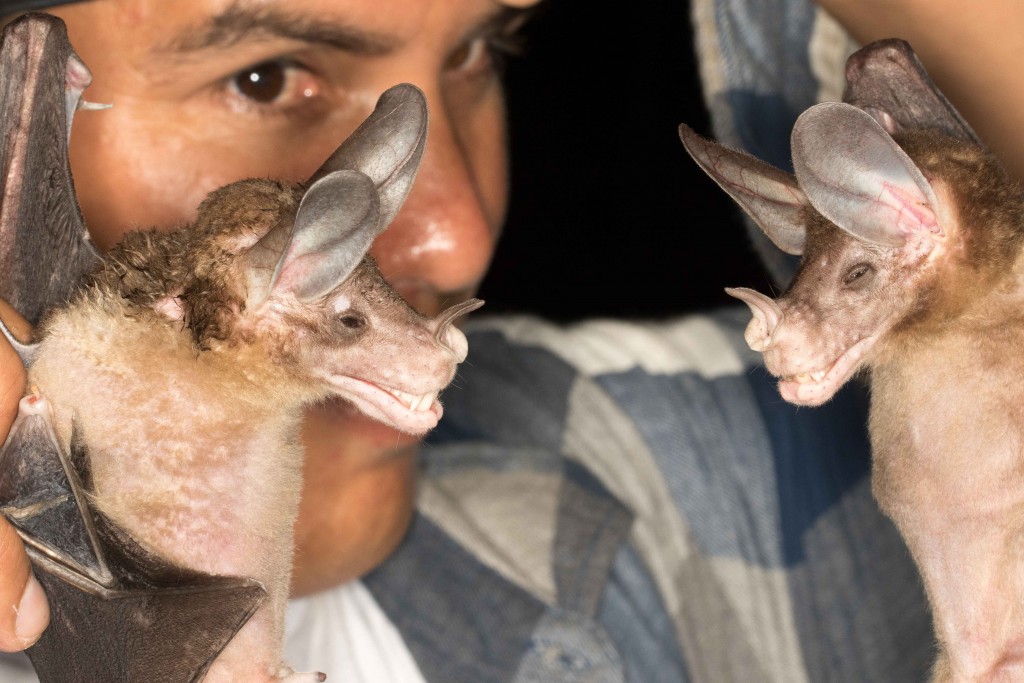
Spectral Bats, Vampyrum spectrum
The wind strengthened and it was hard to get much sleep in the back of the truck, trapped between a fear of falling branches and a fear of Vampire Bat bites. Other bats that evening included more Central American Yellow Bats and Common Vampire Bats.
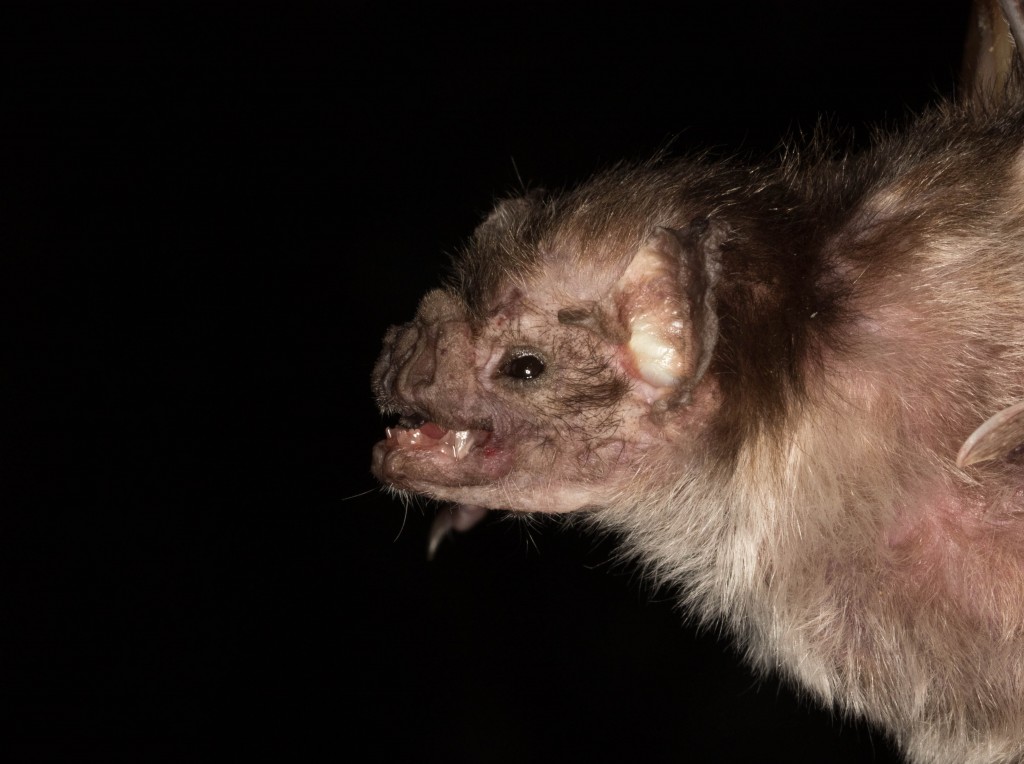
Common Vampire Bat, Desmodus rotundus
The bats dried up at midnight and so at 2 a.m. we packed up for a few hours’ sleep in the hotel. An epic end to a superb three days in Rivas.
El Jaguar: March 23
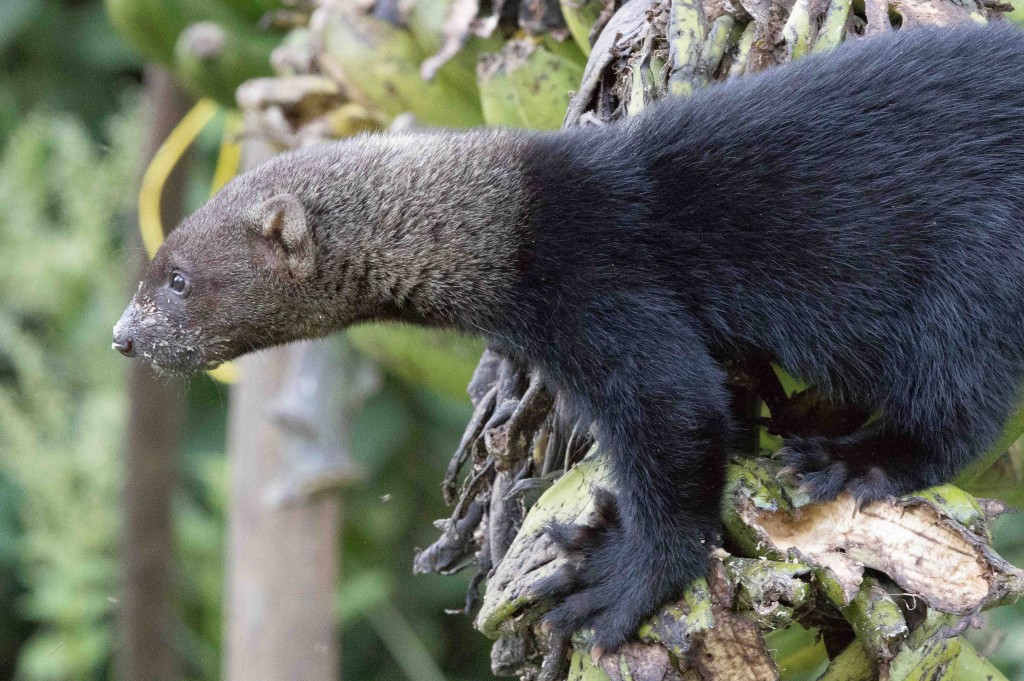
Tayra, Eira barbara, El Jaguar
We were on the road again at 10am for what turned into a five and a half hour drive to El Jaguar, north east of San Rafael del Norte. It is a comfortable lodge, 1,100 metres up in the mountains and my room had a pretty decent view over a small valley.
The lodge was on the itinerary for a number of reasons: some good small mammals, the endemic Richmond’s Squirrel, Bushy-tailed Olingo and some reasonable bats too from time to time. I was planning to visit but the plan became a priority two weeks before the trip when Holly Faithful let me know that a Tayra was hanging around the lodge and she was “sure it would still be there”. Famous last words … Tayras are one of my bogey animals and I’m not sure any mammal watcher has spent as much time as me in the Neotropics and failed to see one.
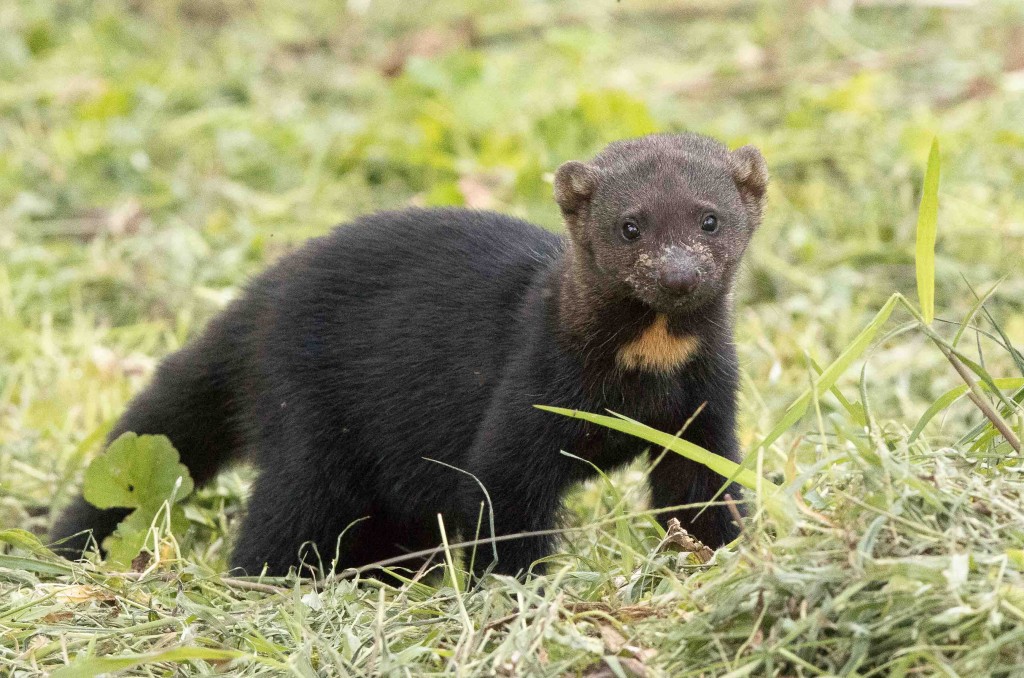
Tayra, Eira barbara
As soon as we arrived I set up shop in front of the bananas (out out for the birds) and waited for a Tayra. It had been seen earlier in the day so I was optimistic. And at 4.30 p.m. a Tayra arrived shortly followed by a second. They spent twenty minutes gorging themselves on bananas. Wonderful.
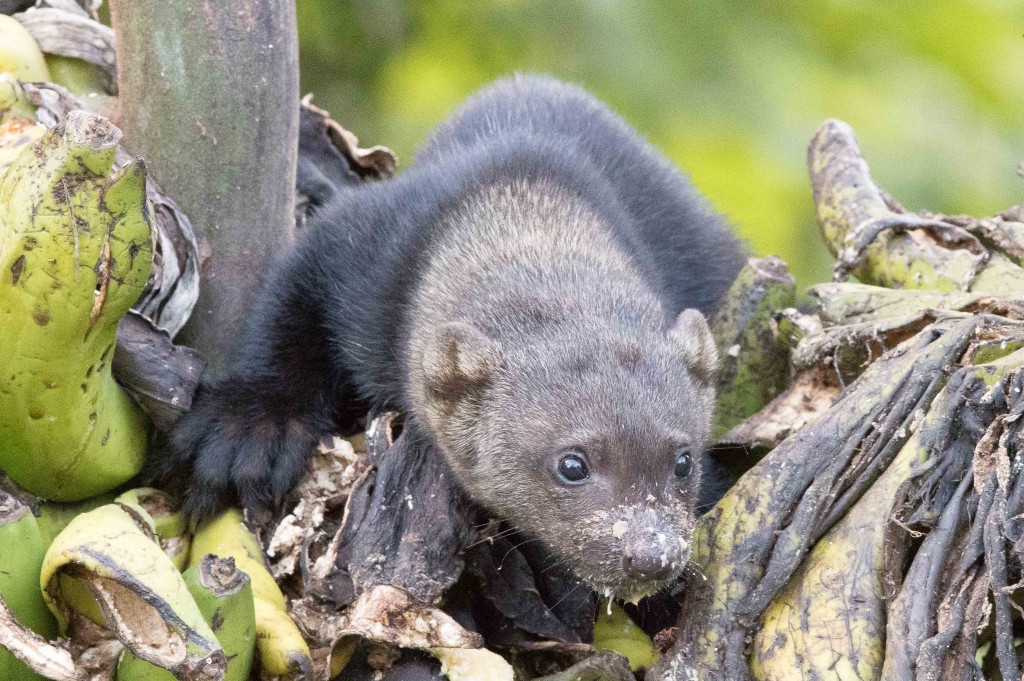
Tayra, Eira barbara
The owners of the lodge thought the animals were a couple of months old and had been abandoned. The ready supply of bananas meant they were rapidly putting on weight (there were desperately skinny when they first arrived). I hope they stay around.
Central American Agoutis put in an appearance under the bananas just before dusk.
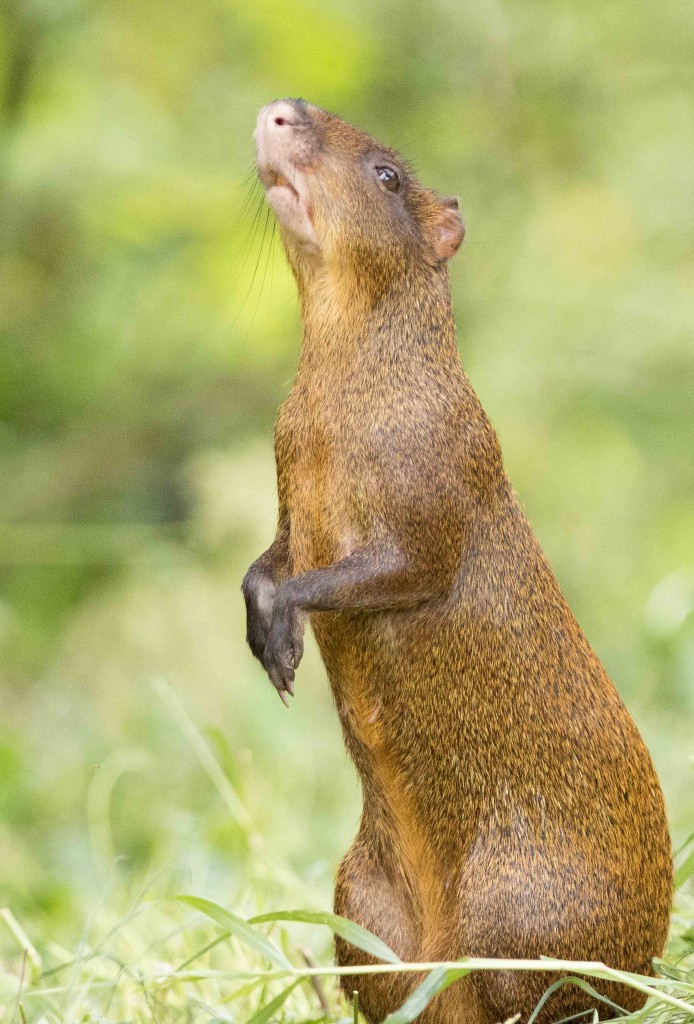
Central American Agouti, Dasyprocta punctata
Very close to the bananas is a storeroom full of corn. This is a major source of rodent action. While Jose and Luis set Sherman traps in the forest, I staked out the room and saw both Deppe’s and Richmond’s Squirrels easily.
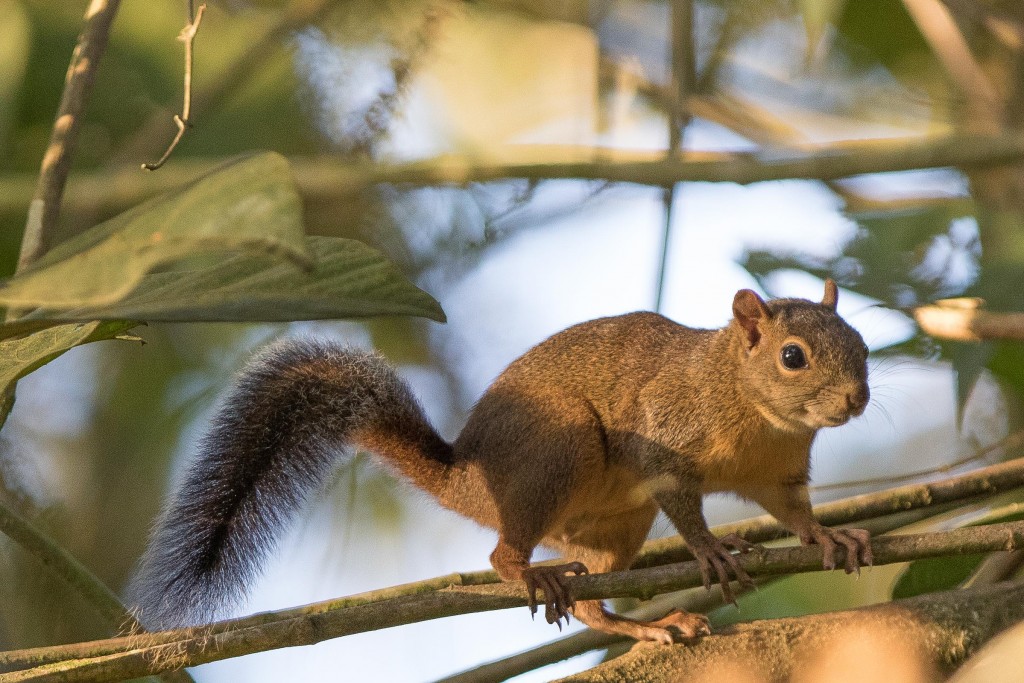
Richmond’s Squirrel, Sciurus richmondi (note the orange belly which helps separate this species from Deppe’s Squirrel)
After dark the squirrels were replaced with gorgeous Vesper Rats
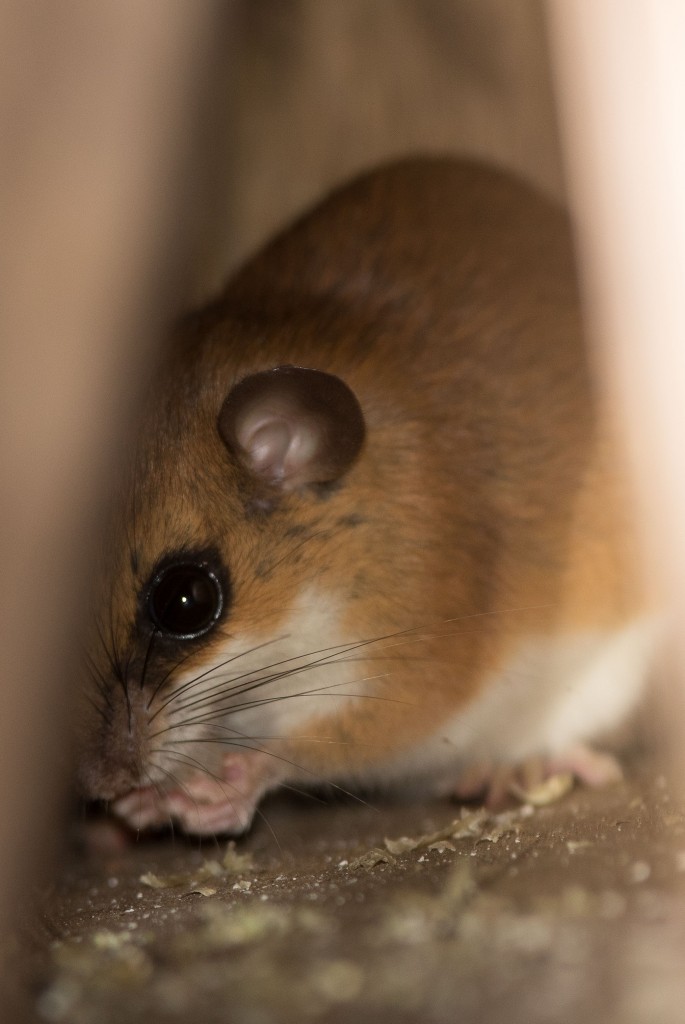
Vesper Rat, Nyctomys sumichrasti
As well as the much smaller, but superficially similar, Short-nosed Harvest Mice. There is still some uncertainty over the harvest mice here as three species may occur: R. mexicanus, austrlis and brevirostris. But this fits best with R brevirostris.
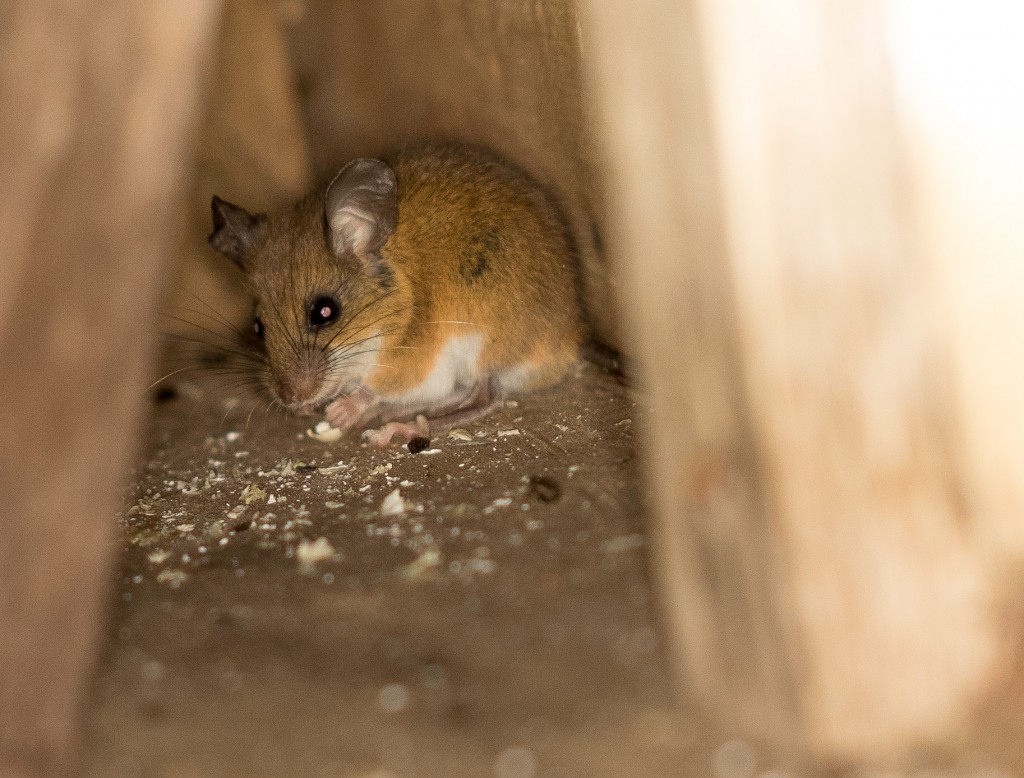
Short-nosed Harvest Mouse, Reithrodontomys brevisrostris
We put a few traps in the storeroom and caught only a House Mouse (surprising given the amount of rodent activity in there every time I looked inside … but then again there was no shortage of food), and an Alfaro’s Rice Rat in the forest.
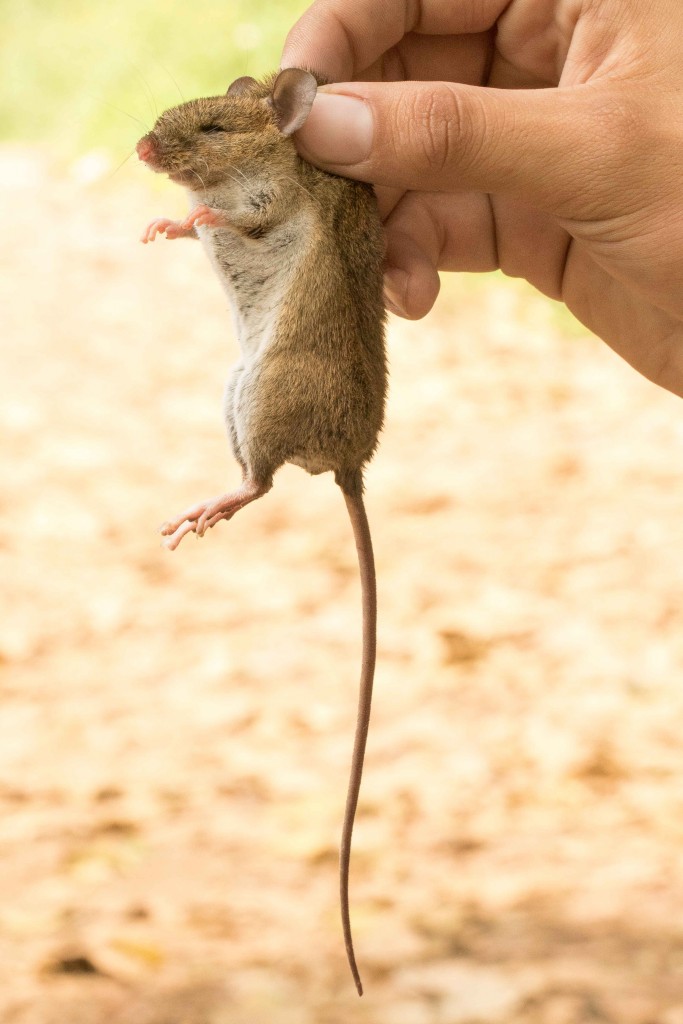
Alfaro’s Rice Rat, Oryzomys alfaroi
Batting was slow in the forest and the main species captured were Thomas’s and Toltec Fruit Eating Bats (the latter new for the trip).
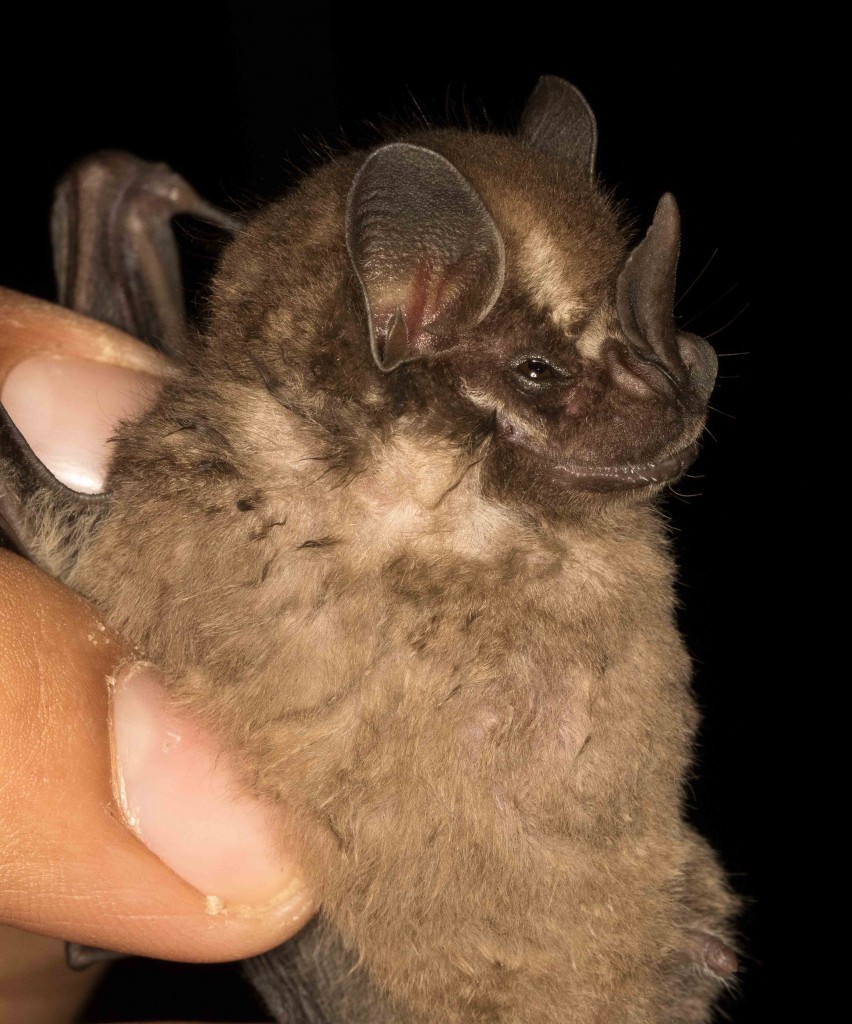
Toltec Fruit-eating Bat, Artibeus toltecus
We also caught two short-tailed bat species.
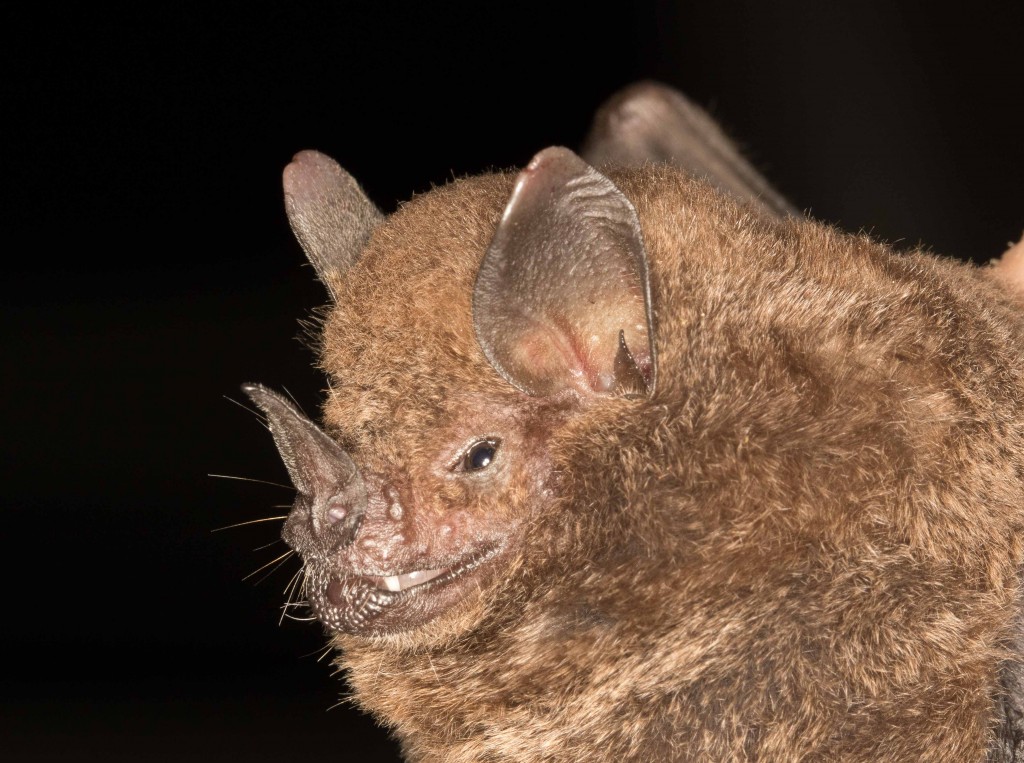
Chestnut Short-tailed Bat, Carollia castanea
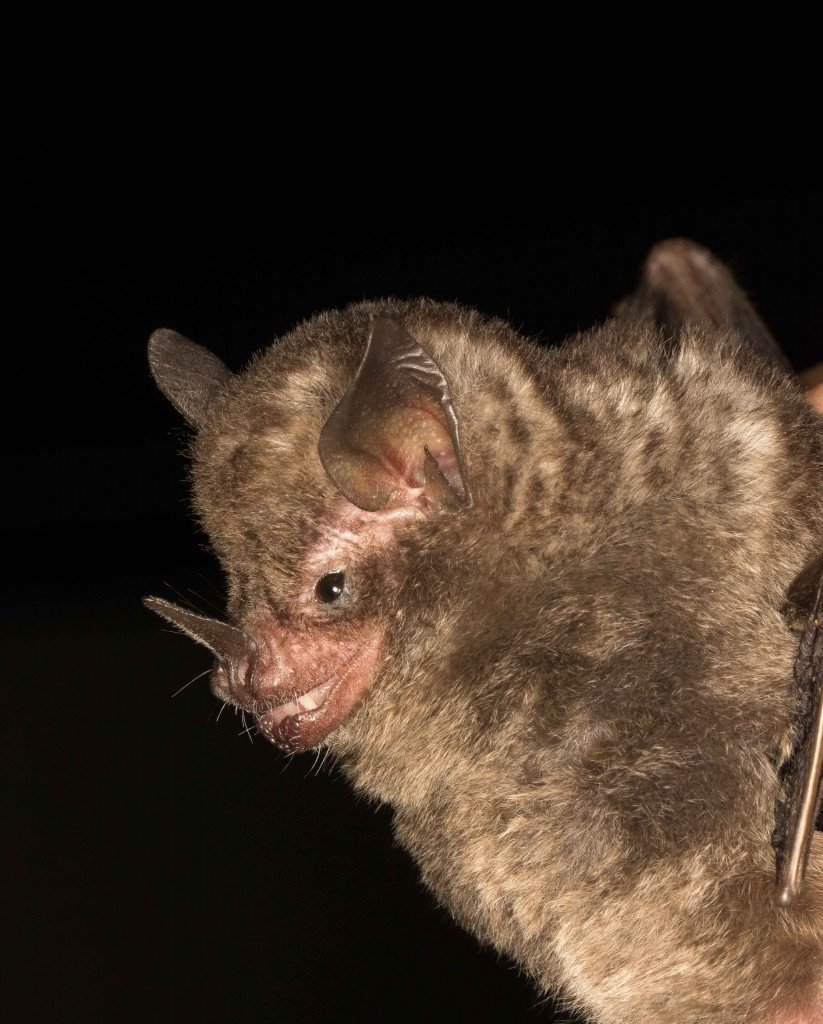
Sowell’s Short-tailed Bat, Carollia sowelli
El Jaguar is also good for Bushy-tailed Olingos and sure enough Luis spotted one close to the bat net shortly after sunset. It was less skittish than usual, tolerating the flashlight to drink nectar from a Banana tree.
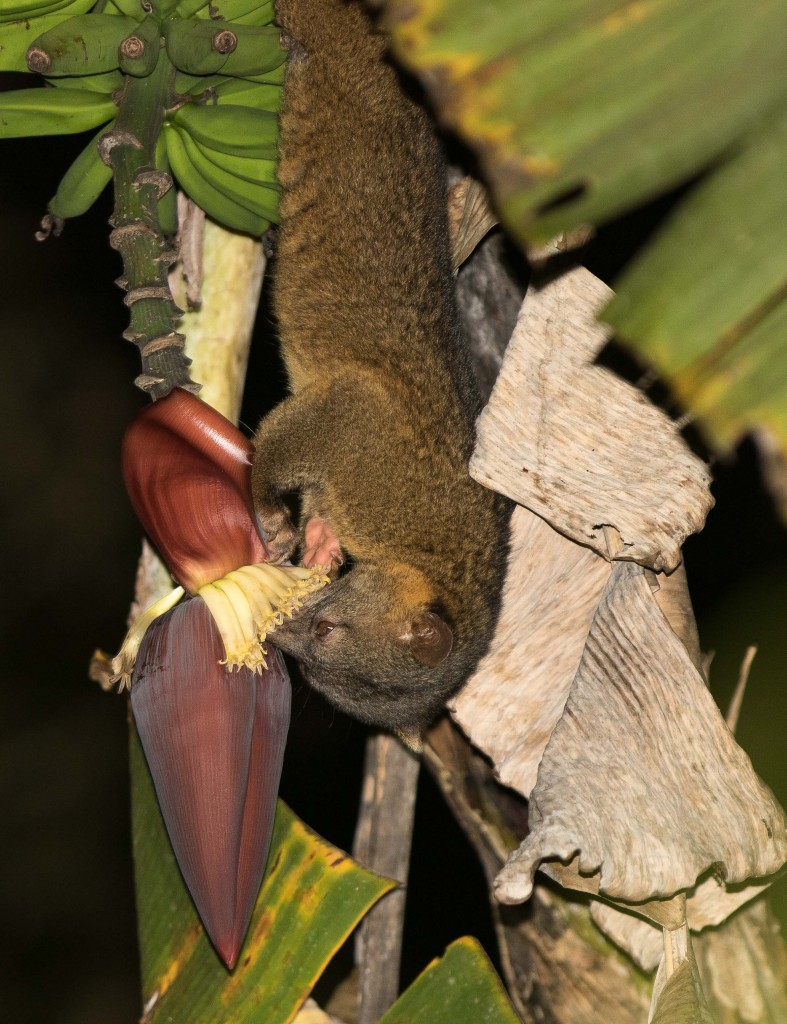
Bushy-tailed Olingo, Bassaricyon gabbii
La Bastilla/Datanli: March 24
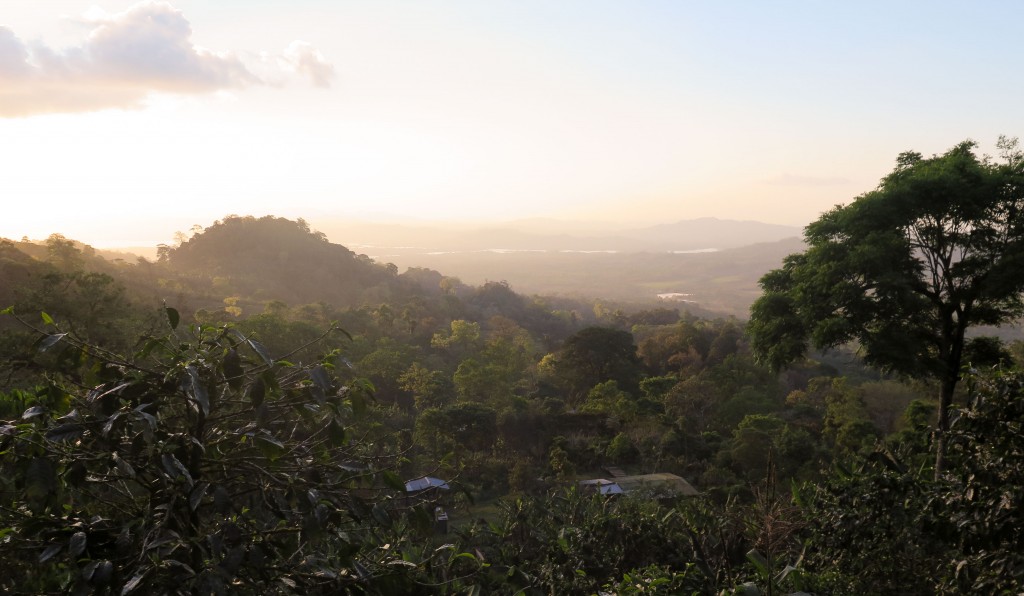
Datanli
Our next stop was La Bastilla, a lovely eco-lodge in a coffee plantation, a couple of hours from El Jaguar, though less than 15 miles as the Spectral Bat flies.
We split up after lunch. Rodrigo, a local guide, and I hiked through the forest above Bastilla setting a long line of traps. Luis stayed near to the lodge to net bats, and Jose drove to Datanli, a small village close to the lodge, and at the other end of the trail that Rodrigo and I took. We arrived on dusk to meet Jose, who had already set up a couple of nets.
Our key targets for the night – based on what Fiona had caught on both trips – were Honduran Yellow-shouldered Bats, Hairy-legged Myotis and Salvin’s Big-eyed Bats.
A Honduran Yellow-shouldered Bat was our first capture – noticeably larger than the Sturnira lilium we had been catching in the lowlands.
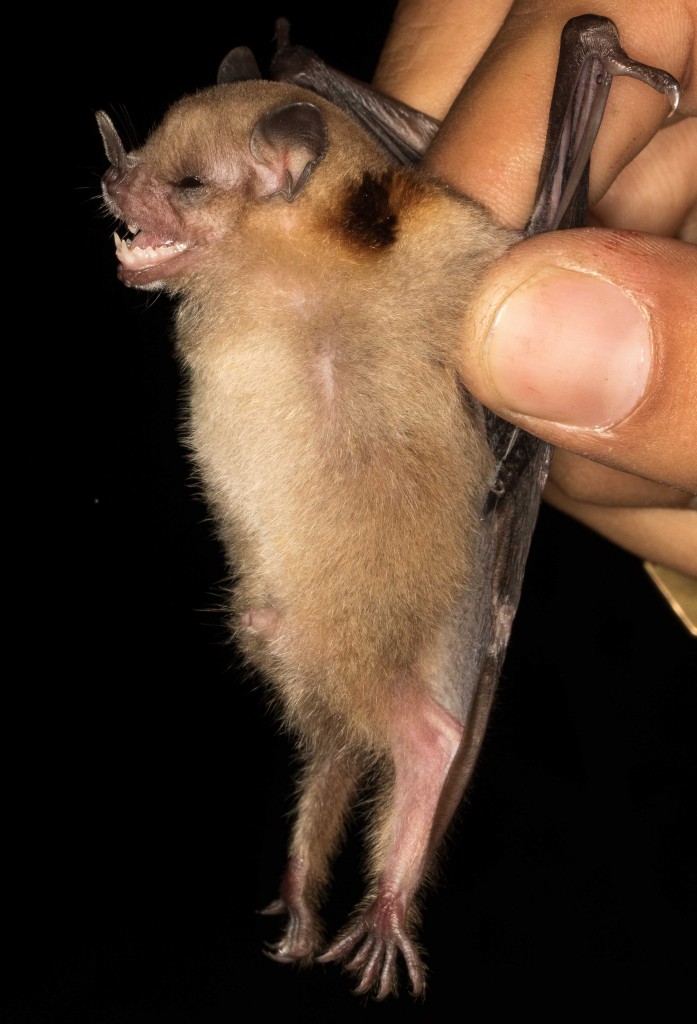
Honduran Yellow-shouldered Bat, Sturnira hondurensis
We very quickly caught several more species.
First, a Brazilian Brown Bat, a new record for the area, was a bonus.
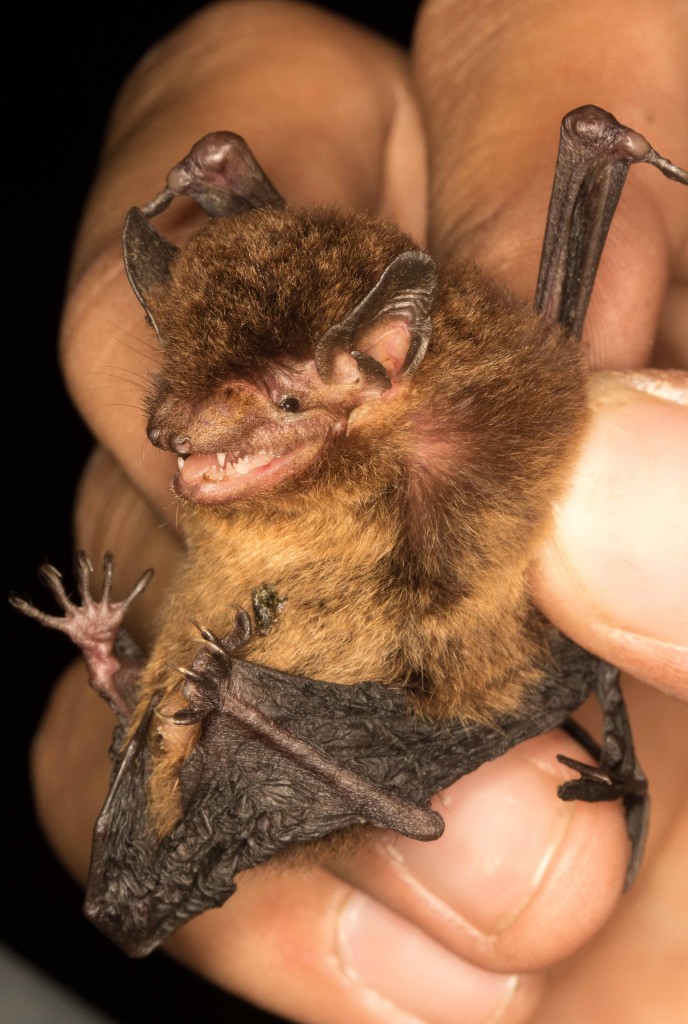
Brazilian Brown Bat, Eptesicus brasiliensis
This was followed quickly by a small nectar bat that had Jose excited. It keyed out as a Godman’s Whiskered Long-nosed Bat. A lifer for both Jose and me.
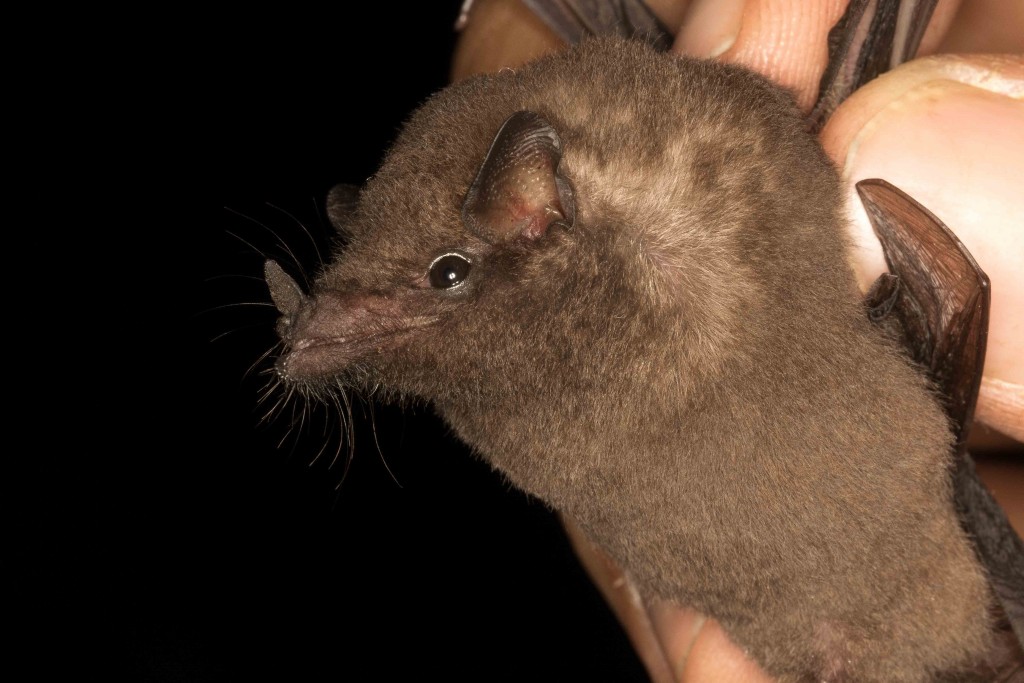
Godman’s Whiskered Long-nosed Bat, Choeroniscus godmani
Next up was the first of two Geoffroy’s Tailless Bats, an uncommon capture, and the first of the trip.
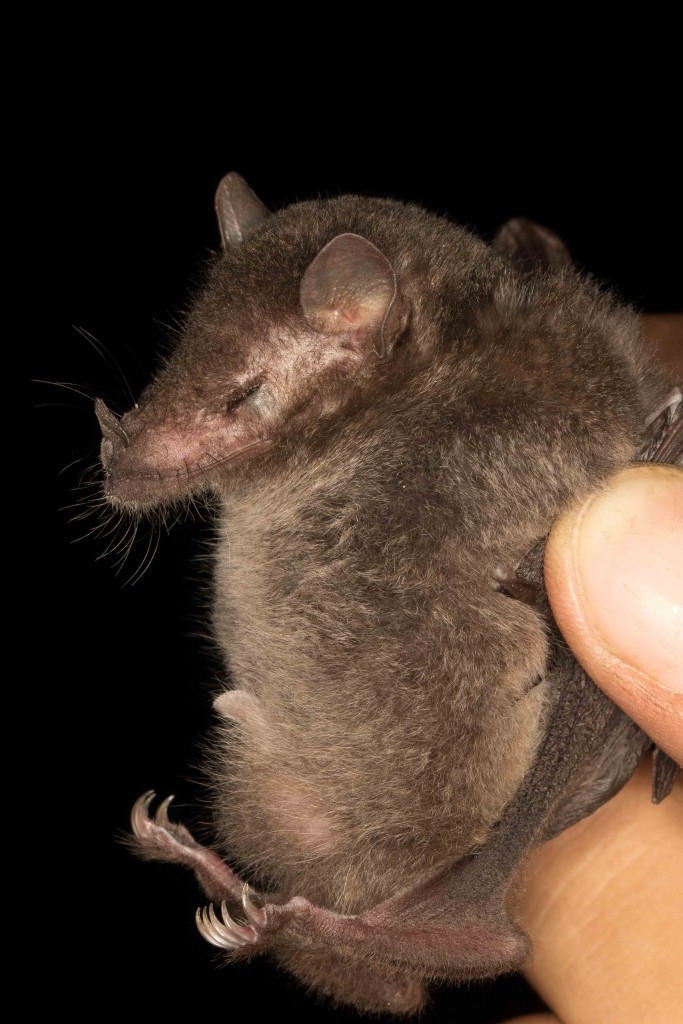
Geoffroy’s Tailless Bat, Anoura geoffroyi
And then we caught our first Brown Long-tongued Bats and more Toltec Fruit-eating Bats.
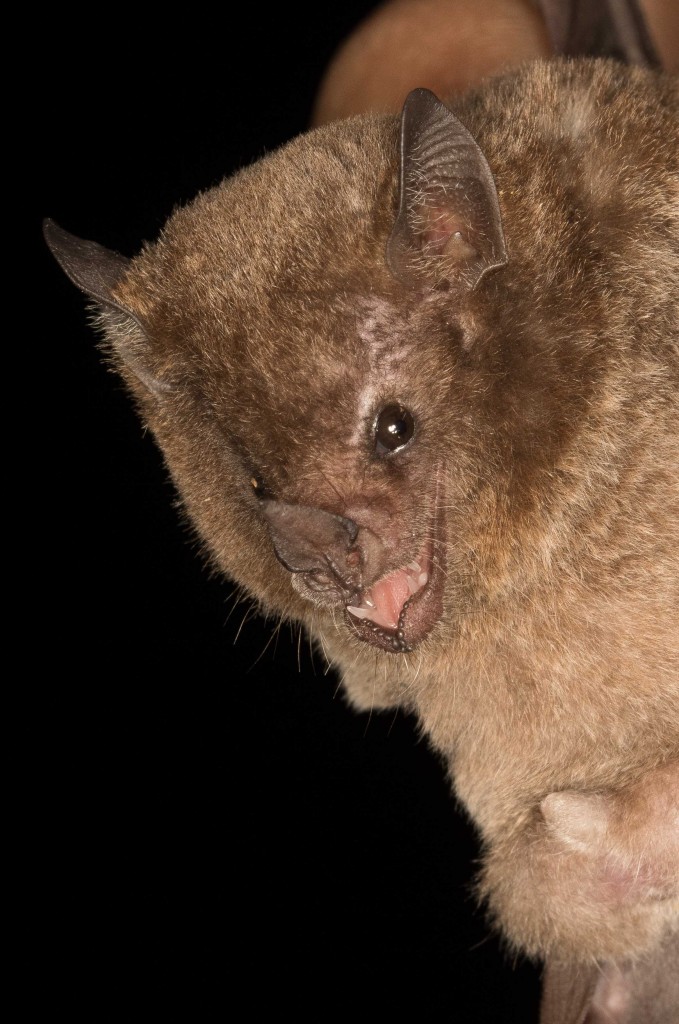
Brown Long-tongued Bat, Glossophaga commissarisi
Other mammals that evening included a Nine-banded Armadillo, which bumbled out of the forest next to the net though I was too slow with my camera.
We packed up at 9 p.m. and had dinner in the village, before heading back to Bastilla to see what Luis had caught. His most unusual capture was a Big Brown Bat.
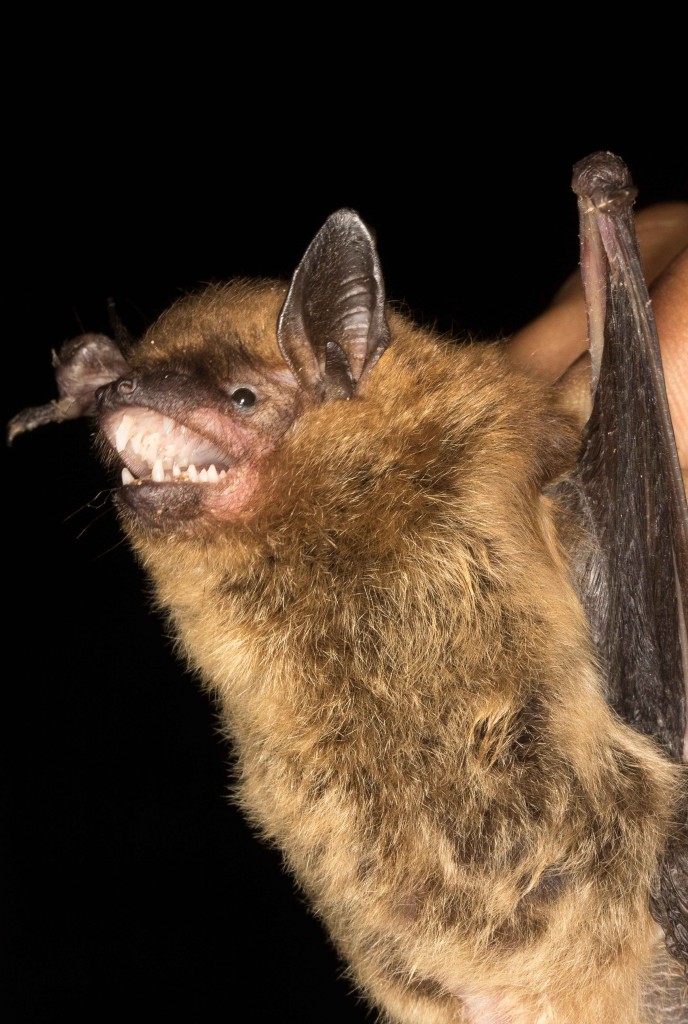
Big Brown Bat, Eptesicus fuscus
He had also got some Jamaican, Toltec and Thomas’s Fruit-eating Bats, Little Yellow-shouldered Bats and Parnell’s Moustached Bats.
Aside from the bats, he’d seen a Paca near the nets and, as we were packing up, we spotted a Grey Four-eyed Opossum (now split into Dark – or possibly Northern – Four-eyed Opossum).
Back at the lodge I found a baby Vesper Rat outside my room that had fallen from its nest (or its mother).
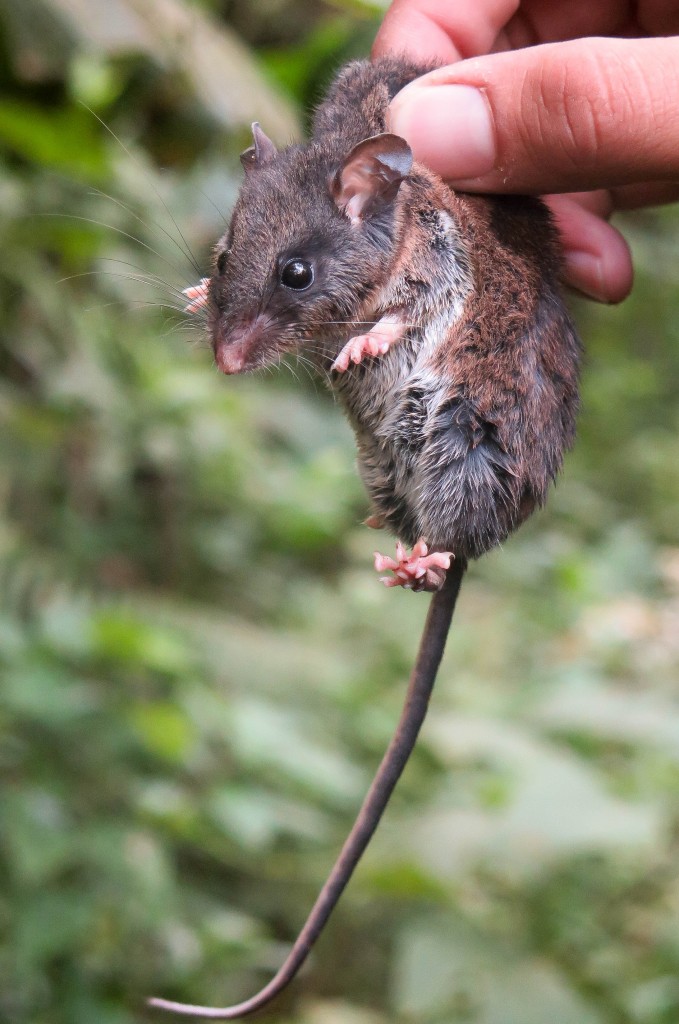
Nicaraguan Deer Mouse, Peromyscus nicaraguae
The next morning we were up at dawn to check the traps. As expected we caught a great many Nicaraguan Deer Mice, a recent split from Mexican Deer Mouse (probably 70% of the traps had a deer mouse inside).
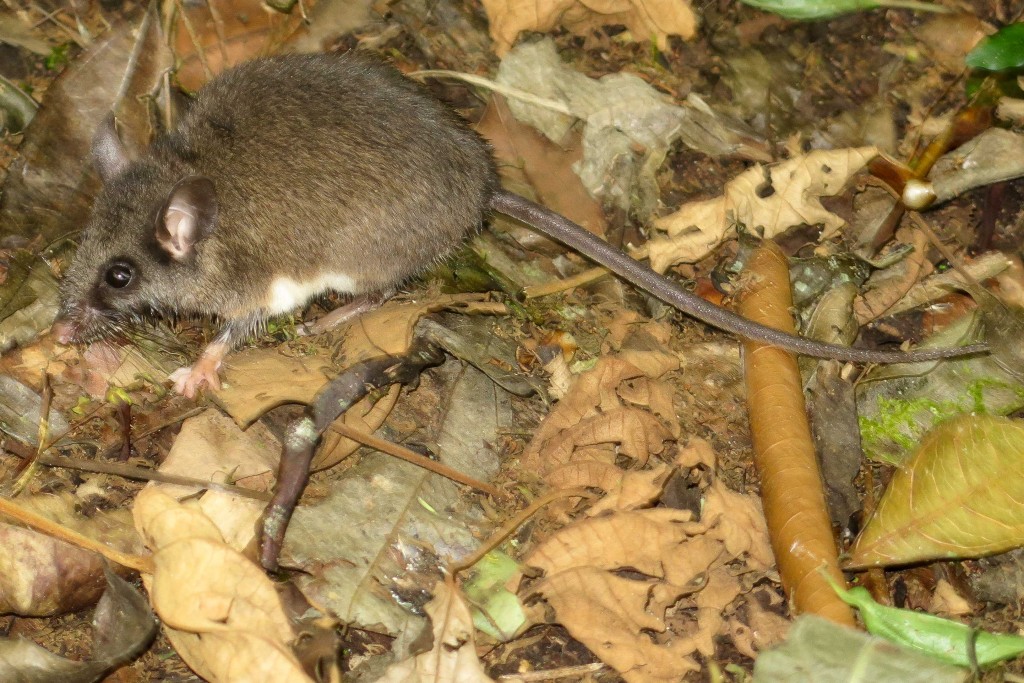
Nicaraguan Deer Mouse, Peromyscus nicaraguae
We also caught one very nice looking (and surprisingly robust) Highland Pocket Mouse.
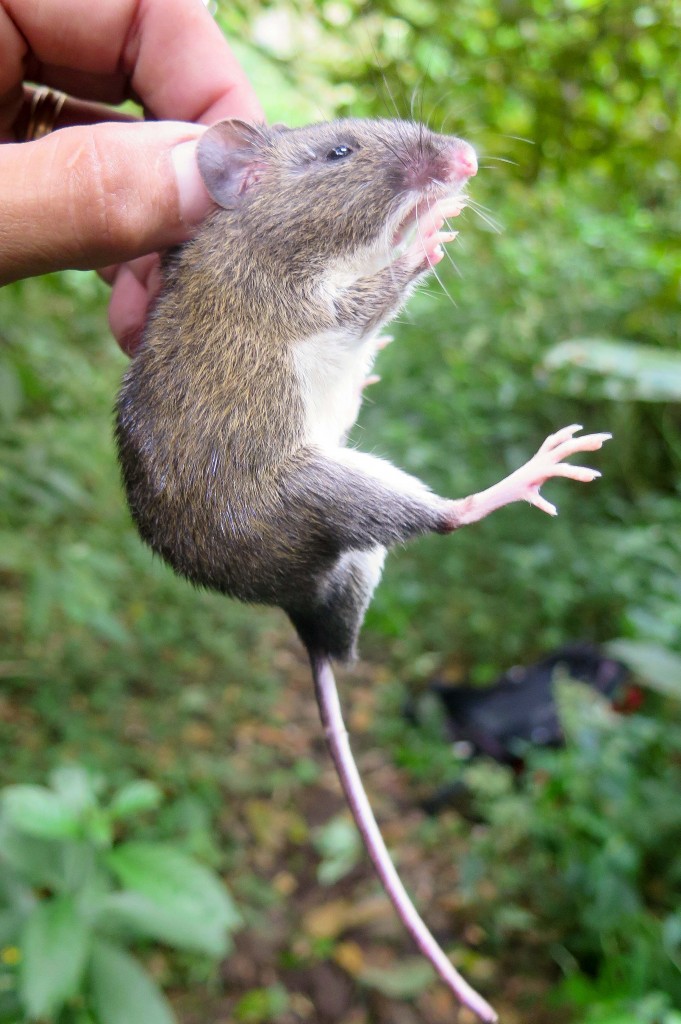
Highland (Forest Spiny) Pocket Mouse, Heteromys desmarestianus
We’d hoped also to catch Zelenodon’s Mouse Opossum: Fiona Reid caught this species on both her trips but we had neither her skill nor her luck. But as a consolation we caught two small Alston’s Singing Mice, a lifer for all of us.
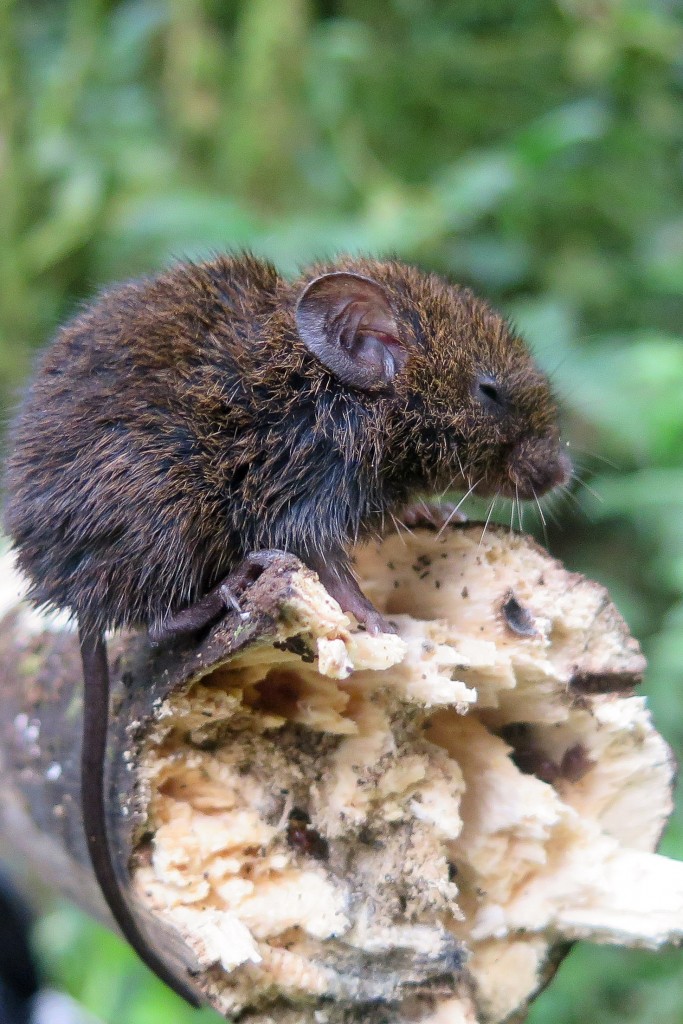
Alston’s Singing Mouse, Scotinomys teguina
The fourth – and final – species was a bedraggled Vesper Rat – nice to see an adult in the hand.
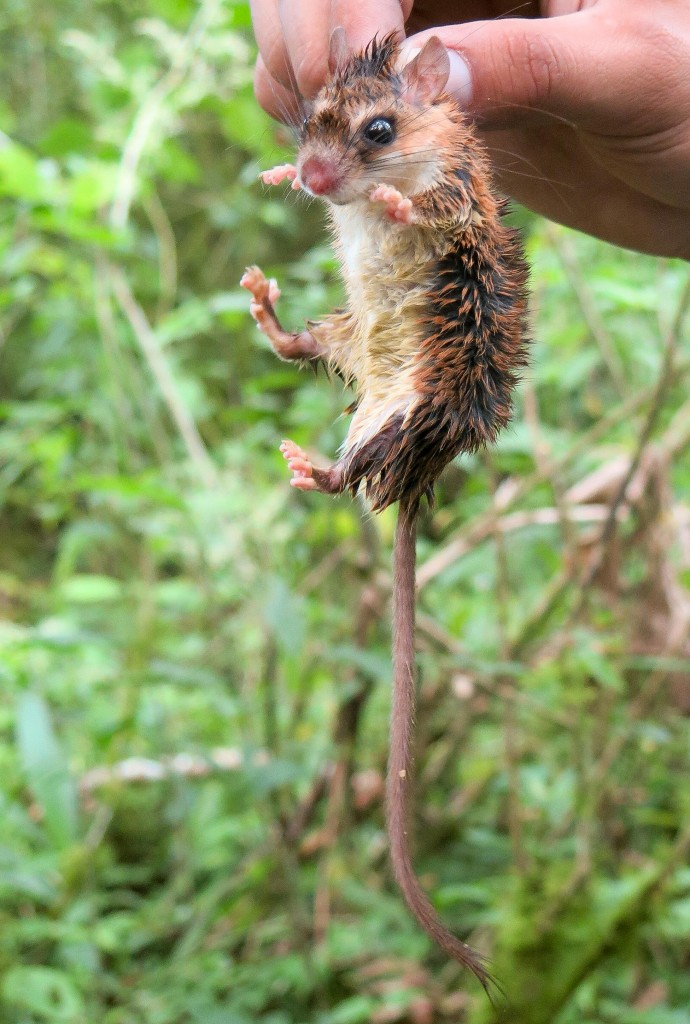
Vesper Rat, Nyctomys sumichrasti
Jose’s original plan was to spend two nights at Bastilla but he was also keen to get me back to Refugio Bartola for a night (where I had been in 2014). In order to do that, however, we would have to leave La Bastilla a day early. We had done well already in Bastilla so by 10 a.m. we were back on the road.
San Miguelito: March 25
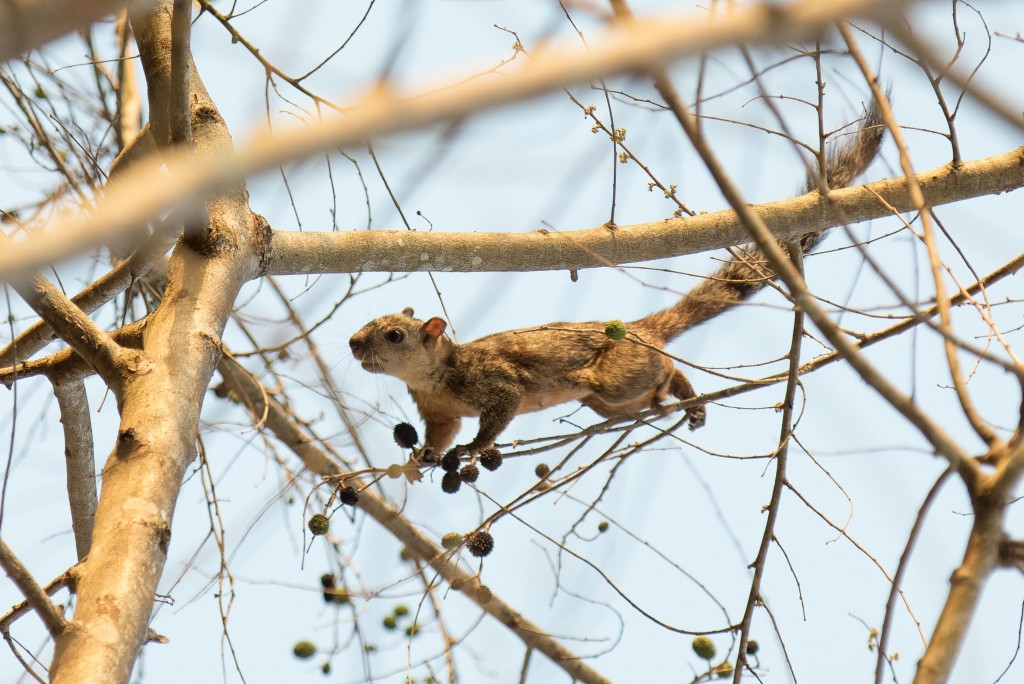
Variegated Squirrel, Sciurus variegatoides
We spent Friday night near the small town of San Miguelito and close to the jumping off point for Refugio Bartola. The plan was to catch bats in a patch of forest that had been productive for Jose a couple of years earlier. A Variegated Squirrel was waiting for us when we arrived.
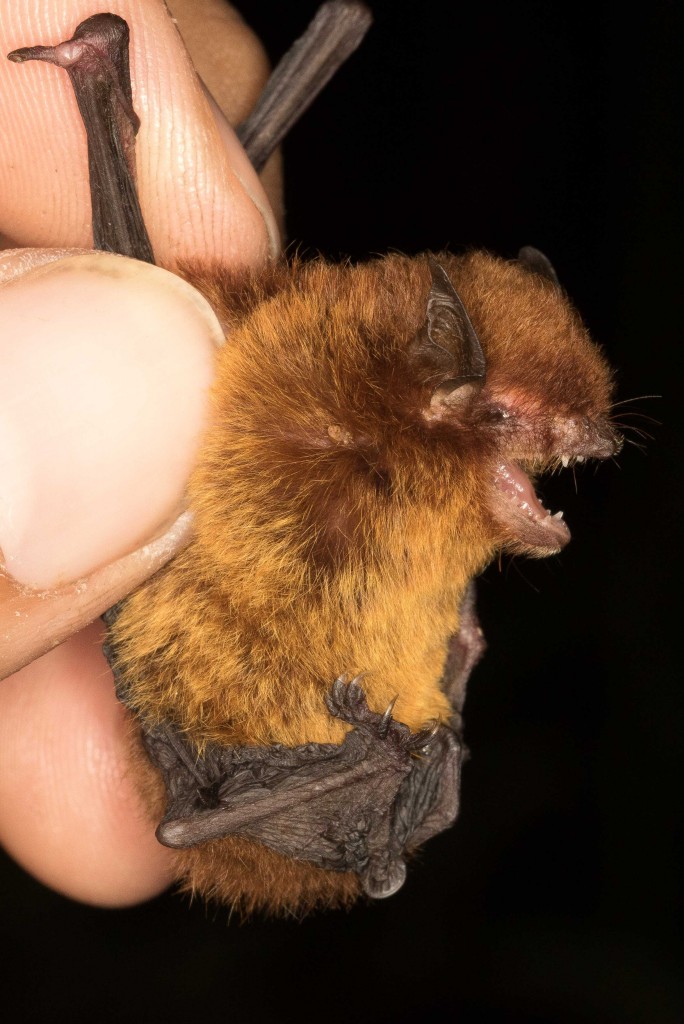
Elegant Myotis, Myotis elegans
Although we caught a bunch of bats we didn’t catch any of the species we were hoping for (particularly Lophostoma silvicola and Rhogeessa io). We did however catch two myotis species: tricky to identify but Fiona Reid confirmed Jose’s opinion that they were Elegant and Mexican Black Myotis. Both new for me and Jose.
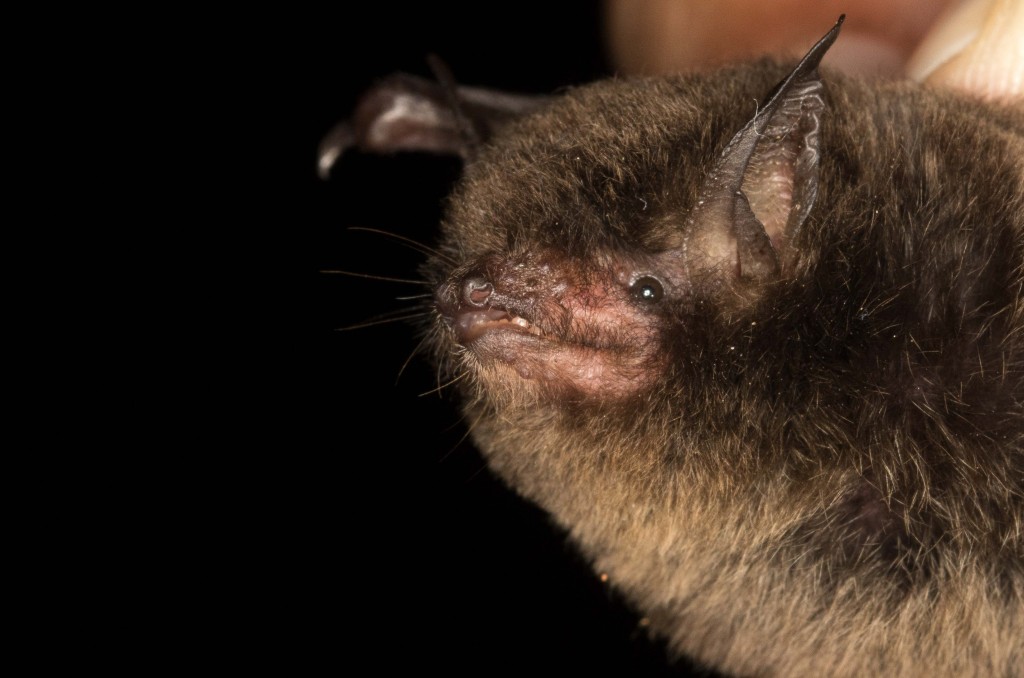
Mexican Black Myotis, Myotis extremus
We also caught two species we’d previously seen roosting: a Greater Spear-nosed Bat,
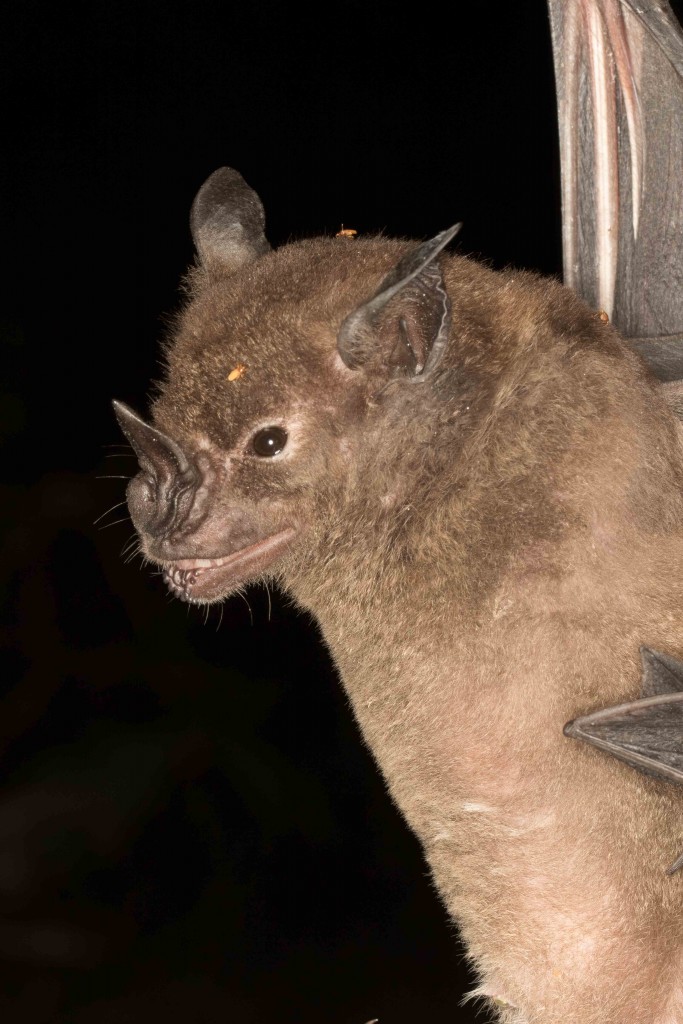
Greater Spear-nosed Bat, Phyllostomus hastatus
and a Greater White-lined Bat.
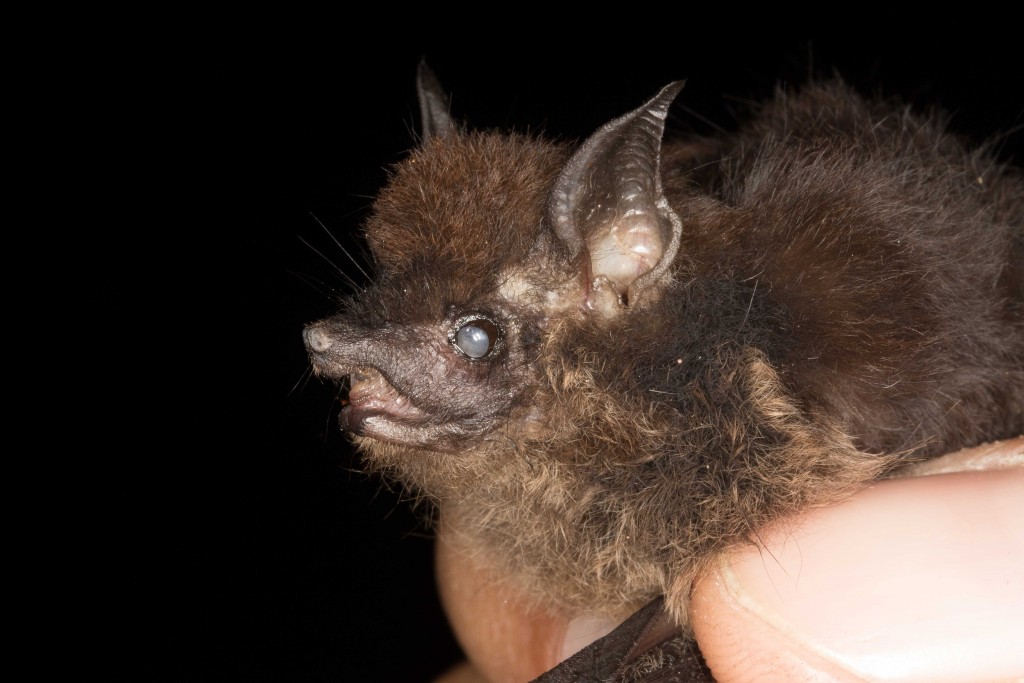
Greater White-lined Bat, Saccopteryx bilineata
The other bats that night mainly comprised Fruit-eating Bats (Jamaican, Thomas’s and Great), Seba’s Short-tailed Bats, Merriam’s Long-tongued Bats and 20+ Common Vampires (Jose found a roost tree close to the net that also housed a couple of Fringe-lipped Bats). We also caught one or two Little Yellow-shouldered and Argentinian Brown Bats.
Bats aside, we saw several Northern Raccoons, a Striped Hog-nosed Skunk, a Common Opossum and the first Forest Rabbit of the trip: except this in fact appears to have been the newly split Gabb’s Cottontail (Sylvilagus gabbi). The forest was full of Four-eyed Opossums, which have now been split and the species here is probably Dark (or possibly Northern) Four eyed Opossum (Philander melanurus).
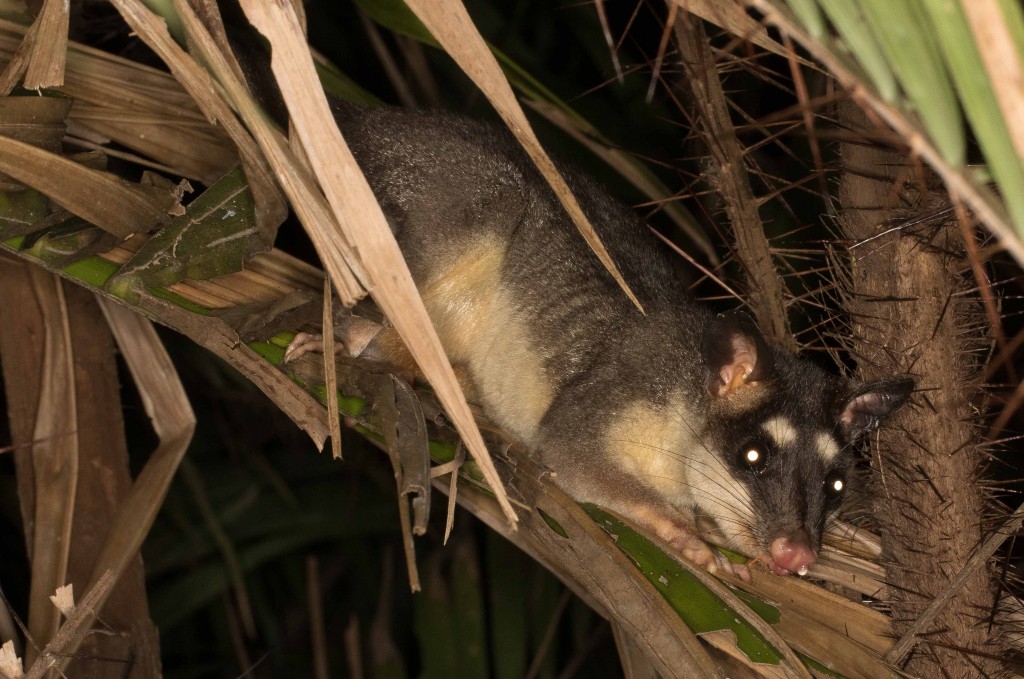
Dark Four-eyed Opossum, Philander melanurus (vossi)
Refugio Bartola: March 26
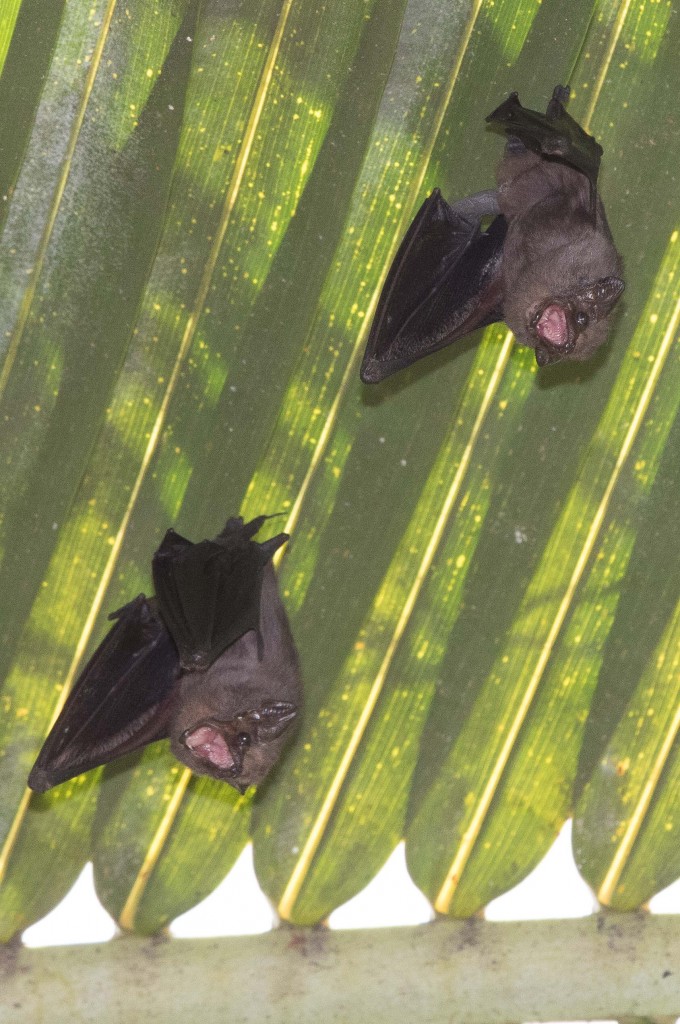
The rare Smoky Bats, Cyttarops alecto, at Refugio Bartola
We left early for our mad dash to Refugio Bartola. But not quite early enough to get the first boat. So we took the 8 a.m. slow boat: even slower than usual because the river was so desperately low. In a week or two it may be too low to operate the boats, leaving people in the communities along the river stranded.
We got to Bartola in time for lunch, and planned to spend the afternoon looking for bat roosts and the evening spotlighting. But the best laid plans of mice and mammal watchers …. I was flying home the next day and so we needed to catch the first boat back to the city of San Carlos. In order to catch that boat – at 5 a.m. – I needed to leave Bartola at 4 a.m. But the river was so low that no boatman was ready to risk the trip in the dark. Cue quick rethink. We had no choice really: and I decided to leave Bartola before dark and overnight in El Castillo to catch the 5 a.m. boat.
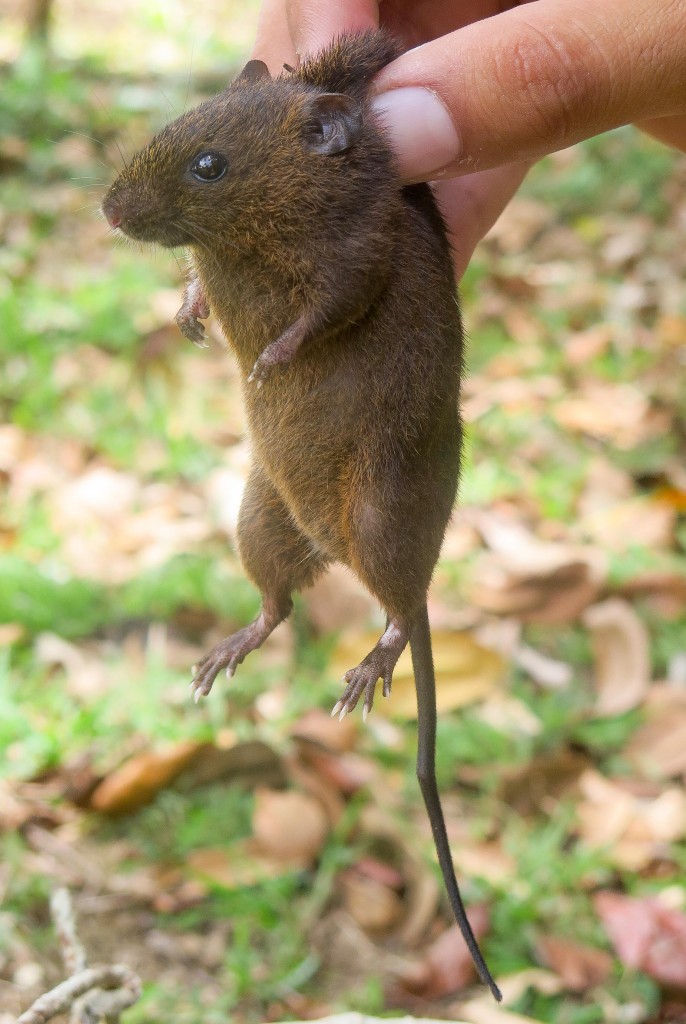
Black and Yello Rice Rat, Melanomys chrysomelas
Jose’s buddy Julio is a guide at Bartola and when he heard we were coming he set a few traps in front of the lodge to catch me a Black and Yellow (formerly Dusky) Rice Rat. A lovely looking thing which we photographed and released: the mammal watching equivalent of home delivery.
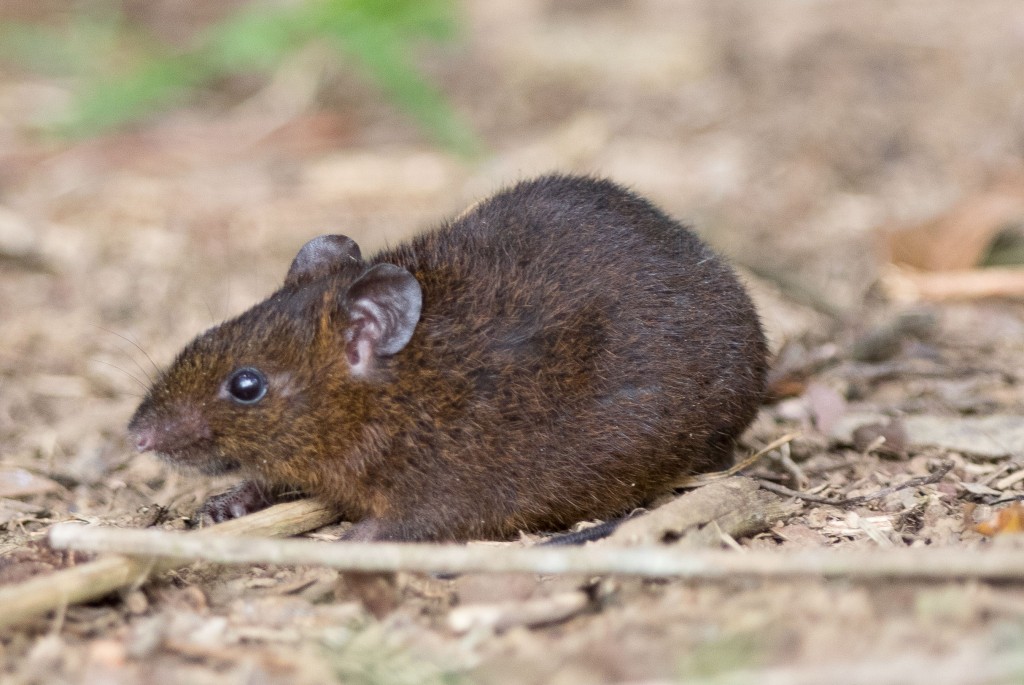
Black and Yellow Rice Rat, Melanomys chrysomelas
After photographing the Common Tent Making Bats
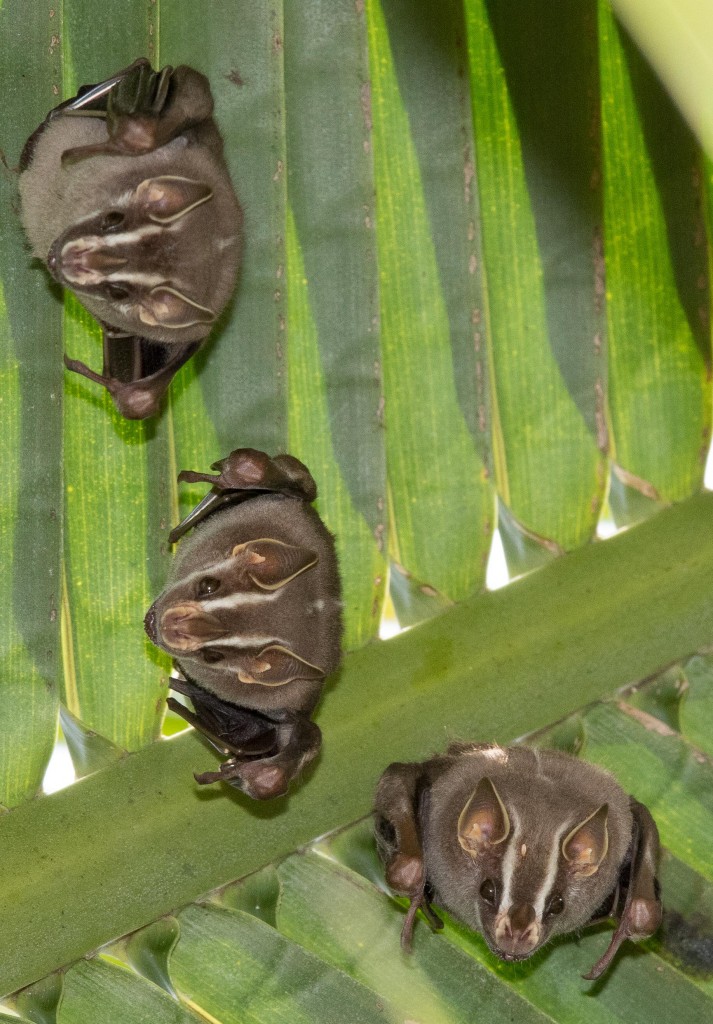
Common Tent-making Bat, Uroderma bilobatum
and Smoky Bats that roost around the lodge we headed off into the jungle for a three hour hike in search of roosting bats.
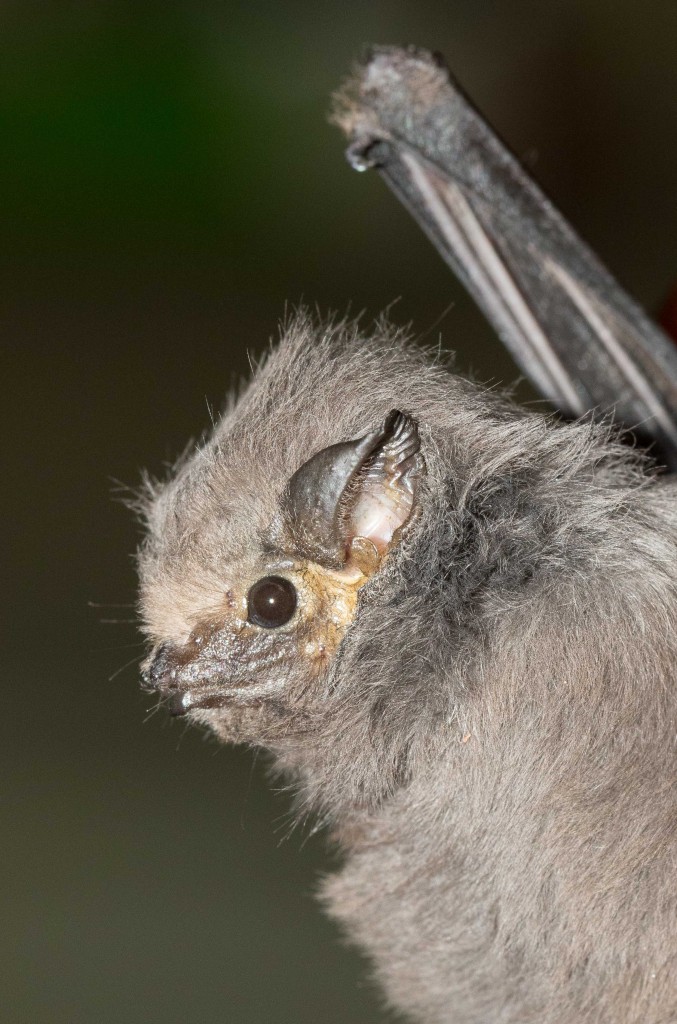
Smoky Sheath-tailed Bat, Cyttarops alecto. Is it just me, or so these bats bear an uncanny resemblance to the Sea Devils, those terrifying villains of Dr Who which haunted my five year old nightmares for several weeks in the early 1970s?
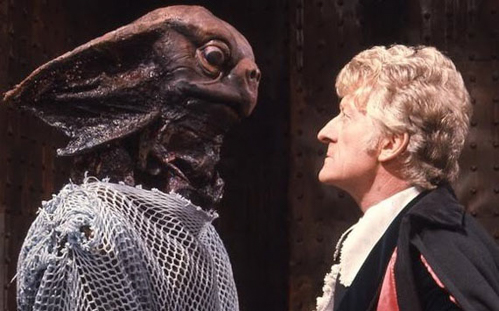
Sea Devil
Our main goal in the forest was a Greater Dog-like Bat roost, but we checked a few other spots along the way and saw our first Northern Big-eared Bat of the trip as well as a few more common species.
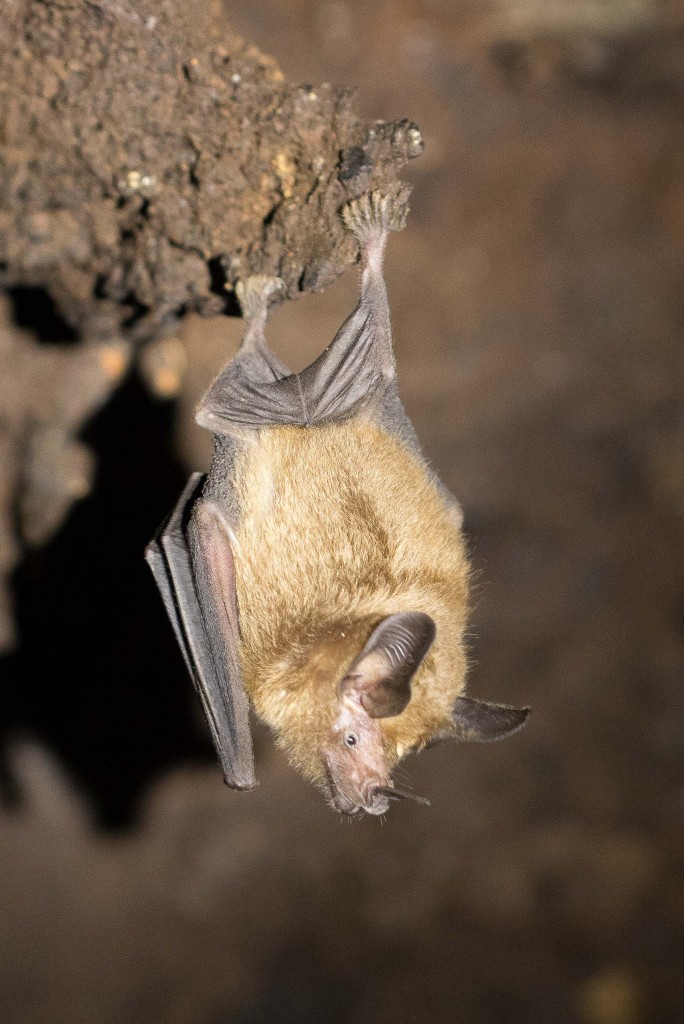
Northern Big-eared Bat, Micronycteris tresamici
Sadly the Dog-like Bats were in neither of their regular roosts. But Jose did find a few Disc-winged Bats inside a rolled up heliconia leaf. Lovely to see this species again.
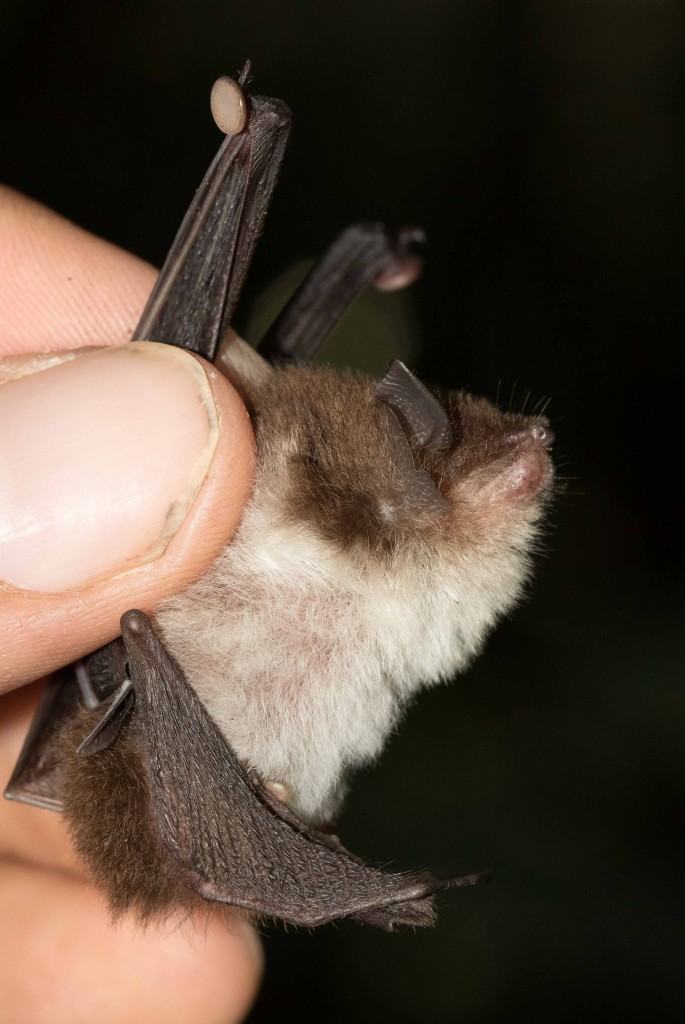
Spix’s Disk-winged Bat, Thyroptera tricolor
We arrived at El Castillo at dusk and set up some nets at the edge of the forest next to town. Though the batting wasn’t great – mainly Jamaican Fruit-eating Bats – we did catch our first Heller’s Broad-nosed Bat of the trip
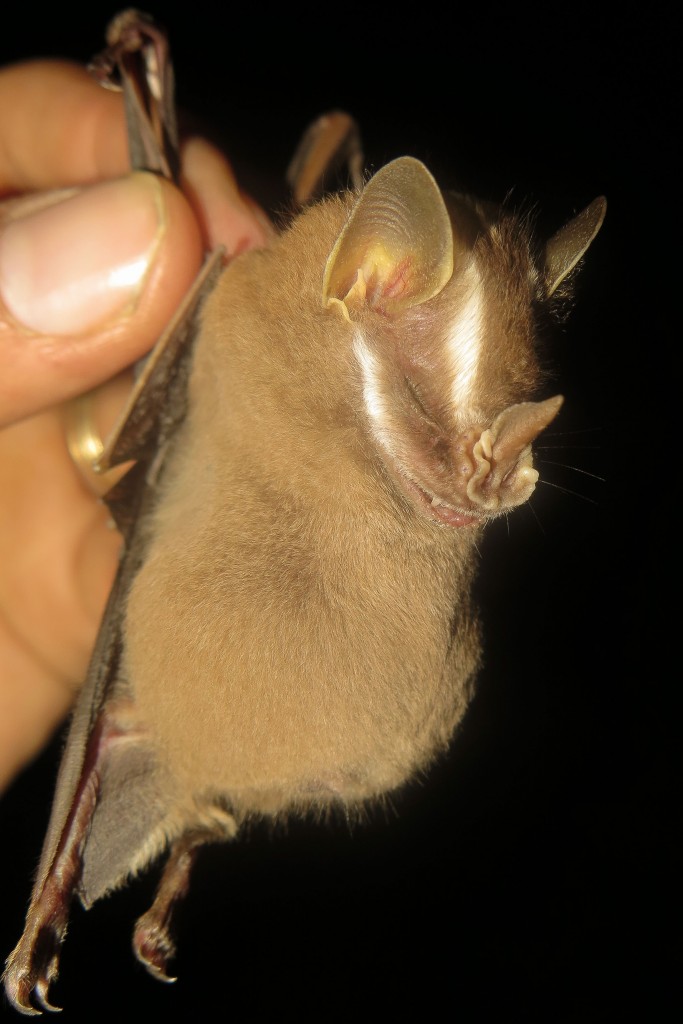
Heller’s Broad-nosed Bat, Platyrrhinus helleri
Jose proved yet again how great a rodent catcher he is, managing to grab a Long-whiskered Rice Rat.
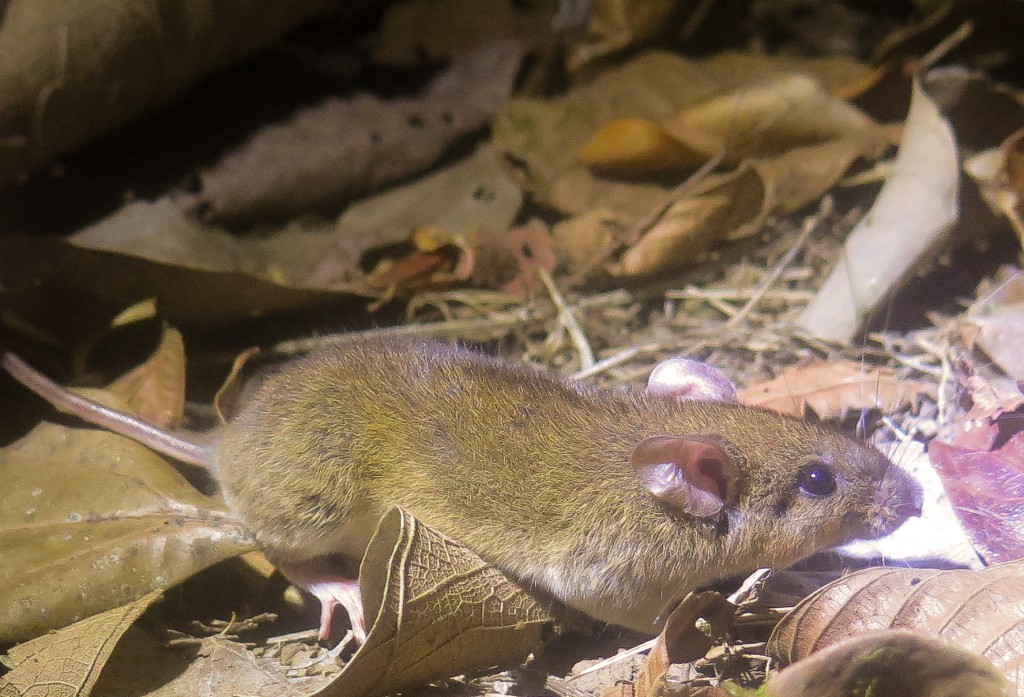
Long-whiskered Rice Rat, Oryzomys bolivaris
Closely followed by a harvest mouse which on closer inspection may well prove to be the most significant find of the trip. There are no records of harvest mice from the area and though Fiona Reid thinks it looks most like a Slender-tailed Harvest Mouse they are not known from anywhere near here so it might also be a new species. The specimen is now with the museum in Managua for identification.
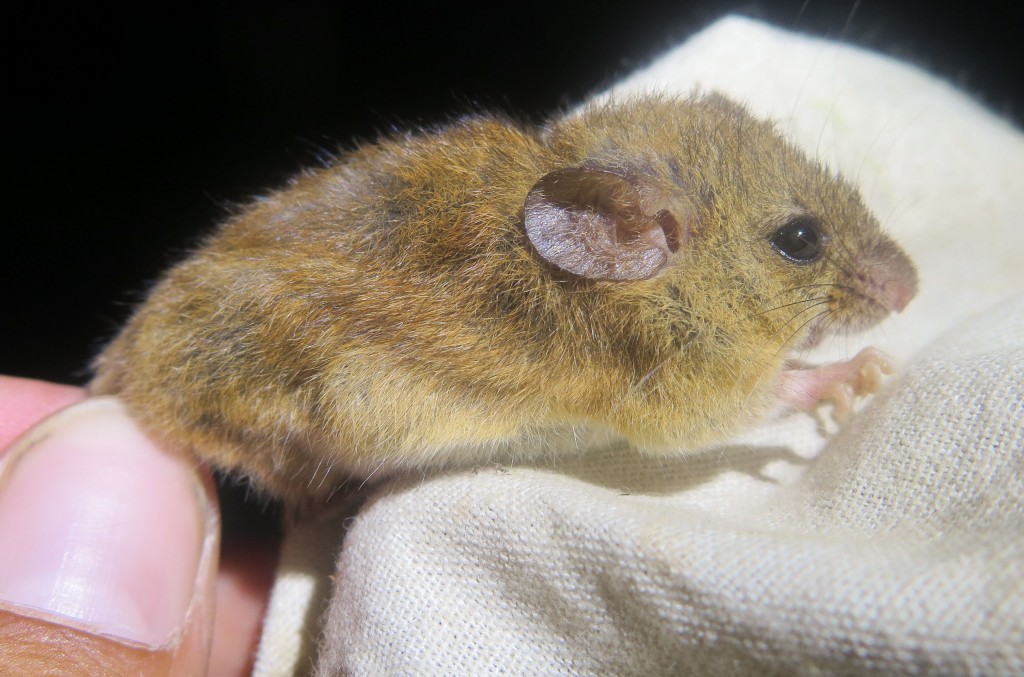
Harvest mouse species
One or two more lifers for me.
We packed up the nets, drank a bunch of Tona (yes, beer!), and walked to the river at midnight in search of Lesser Fishing Bats, which we couldn’t find.
Castilla to Managua: March 27
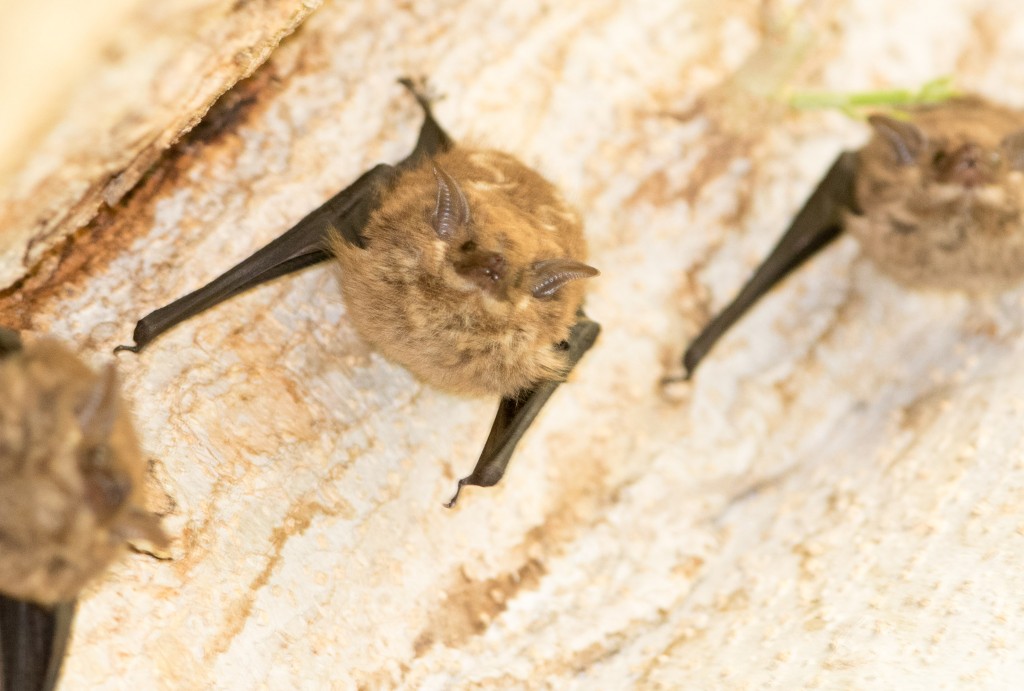
Lesser White-lined Bat, Saccopteryx leptura
The trip home was smooth and we had enough time to detour to Apoyo Lake to see a few Lesser White-lined Bats roosting on a tree in the La Abuelo Hotel car park. My 86th or 87th species for the trip. Quite spectacular for eight nights. There have been a couple of reports from Nicaragua with similar totals so my trip was no fluke. But the combination of Jose’s skills and Fiona Reid’s research, means Nicaraguan mammal watching trips are in a league of their own.

No time to rest at Refugio Bartola
Thank you
A huge thanks to Jose Gabriel and Luis for a truly monumental week. Their skill, energy and enthusiasm were responsible or 90 percent of what we saw. They are great guides, great company and great human beings. If the rest of the world had guides like this there wouldn’t be any mammals left for me to see! So go to Nicaragua now while you still can enjoy weeks like this and before Jose Luis gets head hunted by NatGeo. Also a big thanks to Fiona Reid: her pioneering work has opened up the mammal watching scene in Nicaragua and – as always – she helped confirm and correct our IDs of various species.

Jose and me
Stuff I missed
I cannot complain really can I …? But on the long list I sent Jose there were a few species that we didn’t see (though of course quite a few more that we did see that weren’t on my list to begin with). In particular I would have liked very much to have caught a Wrinkle-faced Bat, seen the Hairy-legged Vampires at Masaya Volcano and the Greater Dog-like Bats at Bartola. We had also hoped to catch a White-throated Round-eared Bat, Nicefoy’s Bat and Hairy-legged Myotis. Zelenedon’s Mouse Opossum would have been nice too. I have promised to return once Jose has perfected plans for seeing these species.
Trip List
Dark (Gray) Four-eyed Opossum Philander (opossum) melanurus (or possibly P. vossi)
Southern Opossum Didelphis marsupialis
Virginia Opossum Didelphis virginiana
Central American Woolly Opossum Caluromys derbianus
Nine-banded Armadillo Dasypus novemcinctus
Northern Tamandua Tamandua mexicana
F Gabb’s Cottontail Sylvilagus gabbi
F Richmond’s Squirrel Sciurus richmondi
Deppe’s Squirrel Sciurus deppei
Variegated Squirrel Sciurus variegatoides
F Alston’s Singing Mouse Scotinomys teguina
F Vesper Rat Nyctomys sumichrasti
F Nicaraguan Deer Mouse Peromyscus nicaraguae
F Short-nosed Harvest Mouse Reithrodontomys brevirostris
F Alfaro’s Rice Rat Oryzomys alfaroi
F Long-whiskered Rice Rat Oryzomys bolivaris
F Black and Yellow Rice Rat Melanomys chrysomelas
House Mouse Mus musculus
F Forest Spiny Pocket Mouse Heteromys desmarestianus
Mexican Hairy Dwarf Porcupine Sphiggurus mexicanus
Central American Agouti Dasyprocta punctata
Paca Cuniculus paca
Gray Fox Urocyon cinereoargenteus
Southern Spotted Skunk Spilogale angustifrons
Hooded Skunk Mephitis macroura
F Striped Hog-nosed Skunk Conepatus semistriatus
F Tayra Eira barbara
F Bushy-tailed Olingo Bassaricyon gabbii
Kinkajou Potos flavus
Northern Raccoon Procyon lotor
Gray Sac-winged Bat Balantiopteryx plicata
Greater White-lined Bat Saccopteryx bilineata
Lesser White-lined Bat Saccopteryx leptura
Lesser Dog-like Bat Peropteryx macrotis
Smoky Sheath-tailed Bat Cyttarops alecto
Greater Fishing Bat Noctilio leporinus
Lesser Moustached Bat Pteronotus personatus
Mesoamerican Moustached Bat Pteronotus mesoamericanus
Big Naked-backed Bat Pteronotus gymnonotus
Hairy Big-eared Bat Micronycteris hirsuta
Northern Big-eared Bat Micronycteris tresamici
F Tiny Big-eared Bat Micronycteris minuta
F Schmidts’ Big-eared Bat Micronycteris schmidtorum
F Long-legged Bat Macrophyllum macrophyllum
F Pygmy Round-eared Bat Lophostoma brasiliense
Northern Stripe-headed Round-eared Bat Tonatia bakeri
F Pale Spear-nosed Bat Phyllostomus discolor
Greater Spear-nosed Bat Phyllostomus hastatus
Fringe-lipped Bat Trachops cirrhosus
Spectral Bat Vampyrum spectrum
Brown Long-tongued Bat Glossophaga commissarisi
Merriam’s Long-tongued Bat Glossophaga mutica
Geoffroy’s Tailless Bat Anoura geoffroyi
F Godman’s Whiskered Long-nosed Bat Choeroniscus godmani
Chestnut Short-tailed Bat Carollia castanea
Seba’s Short-tailed Bat Carollia perspicillata
Sowell’s Short-tailed Bat Carollia sowelli
Gray Short-tailed Bat Carollia subrufa
F Little Yellow-shouldered Bat Sturnira lilium
F Honduran Yellow-shouldered Bat Sturnira hondurensis
Common Tent-making Bat Uroderma bilobatum
Heller’s Broad-nosed Bat Platyrrhinus helleri
Jamaican Fruit-eating Bat Artibeus jamaicensis
Great Fruit-eating Bat Artibeus lituratus
Thomas’ Fruit-eating Bat Artibeus watsoni
Toltec Fruit-eating Bat Artibeus toltecus
Common Vampire Bat Desmodus rotundus
Spix’s Disk-winged Bat Thyroptera tricolor
F Woolly Funnel-eared Bat Natalus lanatus
Mexican Greater Funnel-eared Bat Natalus mexicanus
F Fierce Bonneted Bat Eumops ferox
F Mexican Dog-faced bat Cynomops mexicanus
F Big Crested Mastiff Bat Promops centralis
F Bonda Mastiff Bat Molossus bondae
Pallas’ Mastiff Bat Molossus molossus
F Miller’s Mastiff Bat Molossus pretiosus
F Alvarez’s Mastiff Bat Molossus alvarezi
F Brazilian Brown Bat Eptesicus brasiliensis
Argentine Brown Bat Eptesicus furinalis
Big Brown Bat Eptesicus fuscus
F Central American Yellow Bat Rhogeessa tumida
F Elegant Myotis Myotis elegans
F Mexican Black Myotis Myotis extremus
Panamanian White-throated Capuchin Cebus imitator
Central American Spider Monkey Ateles geoffroyi
Mantled Howler Monkey Alouatta palliata
86 species including 32 that were new for me… plus a mystery harvest mouse.
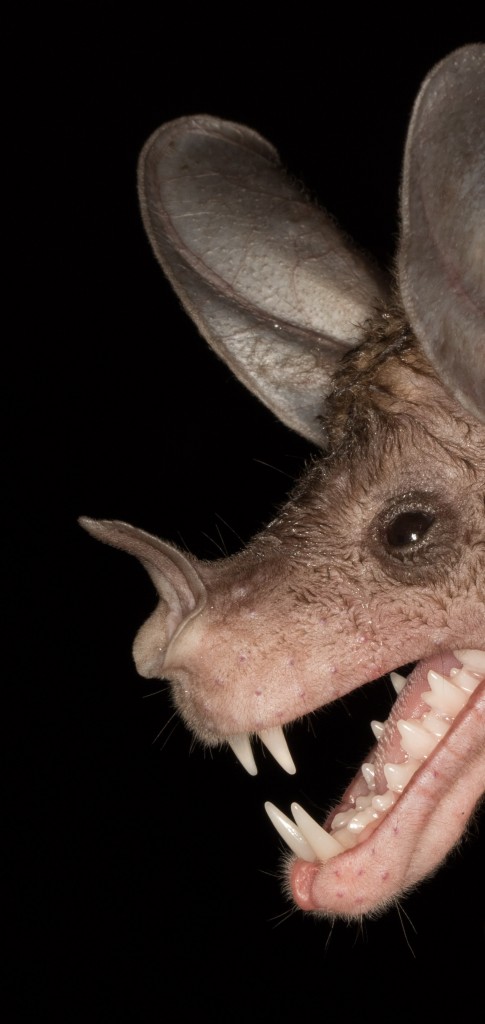
Spectral Bat, Vampyrum spectrum


Leave a Reply
You must be logged in to post a comment.